Proposal for Implementation of ERP System for Improving Organisational Productivity
VerifiedAdded on 2023/04/23
|25
|4612
|286
AI Summary
This report includes a proposal for the proposed ERP system implementation that will not only enhance the overall operational system of the company but will also considerably increase the organizational productivity after implementation of the system is complete.
Contribute Materials
Your contribution can guide someone’s learning journey. Share your
documents today.
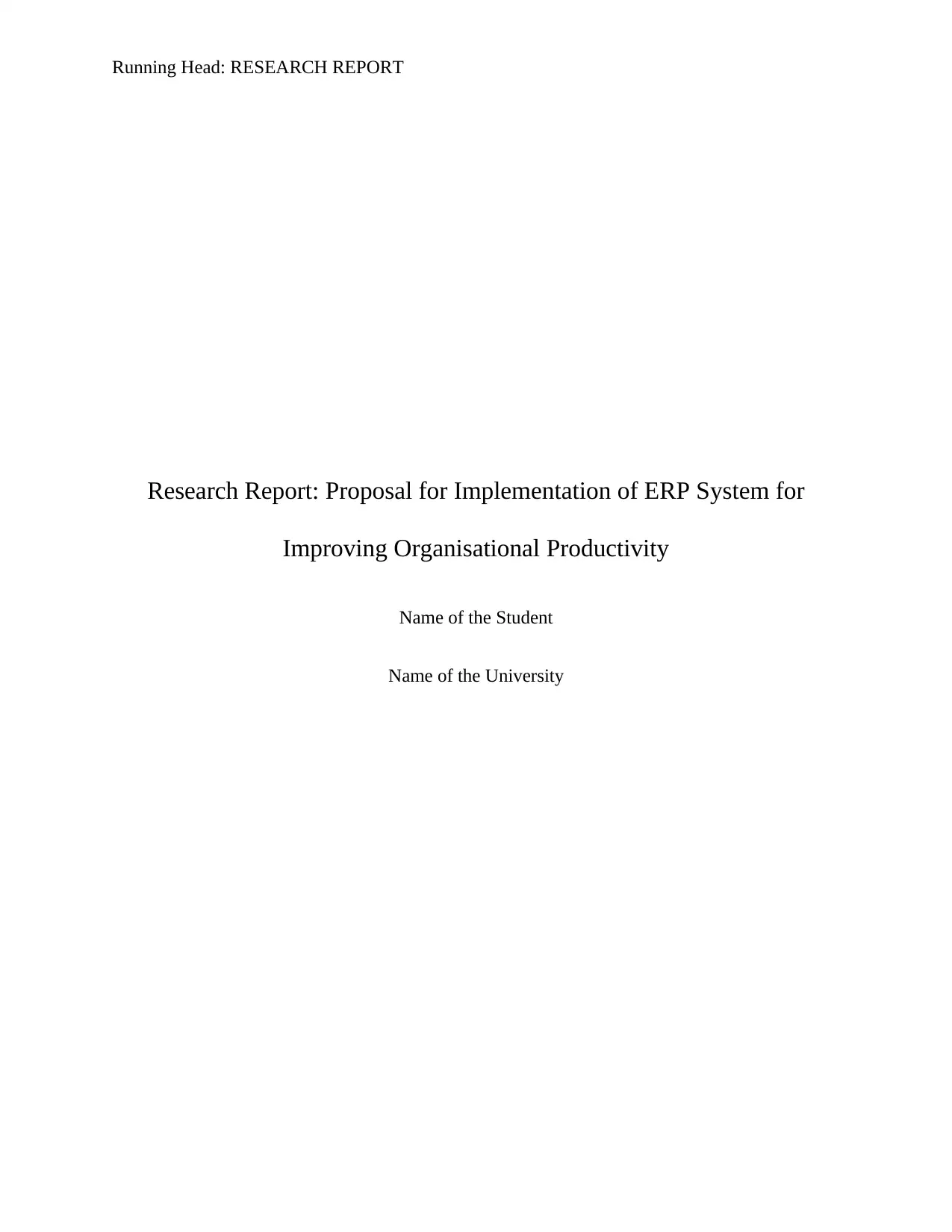
Running Head: RESEARCH REPORT
Research Report: Proposal for Implementation of ERP System for
Improving Organisational Productivity
Name of the Student
Name of the University
Research Report: Proposal for Implementation of ERP System for
Improving Organisational Productivity
Name of the Student
Name of the University
Secure Best Marks with AI Grader
Need help grading? Try our AI Grader for instant feedback on your assignments.
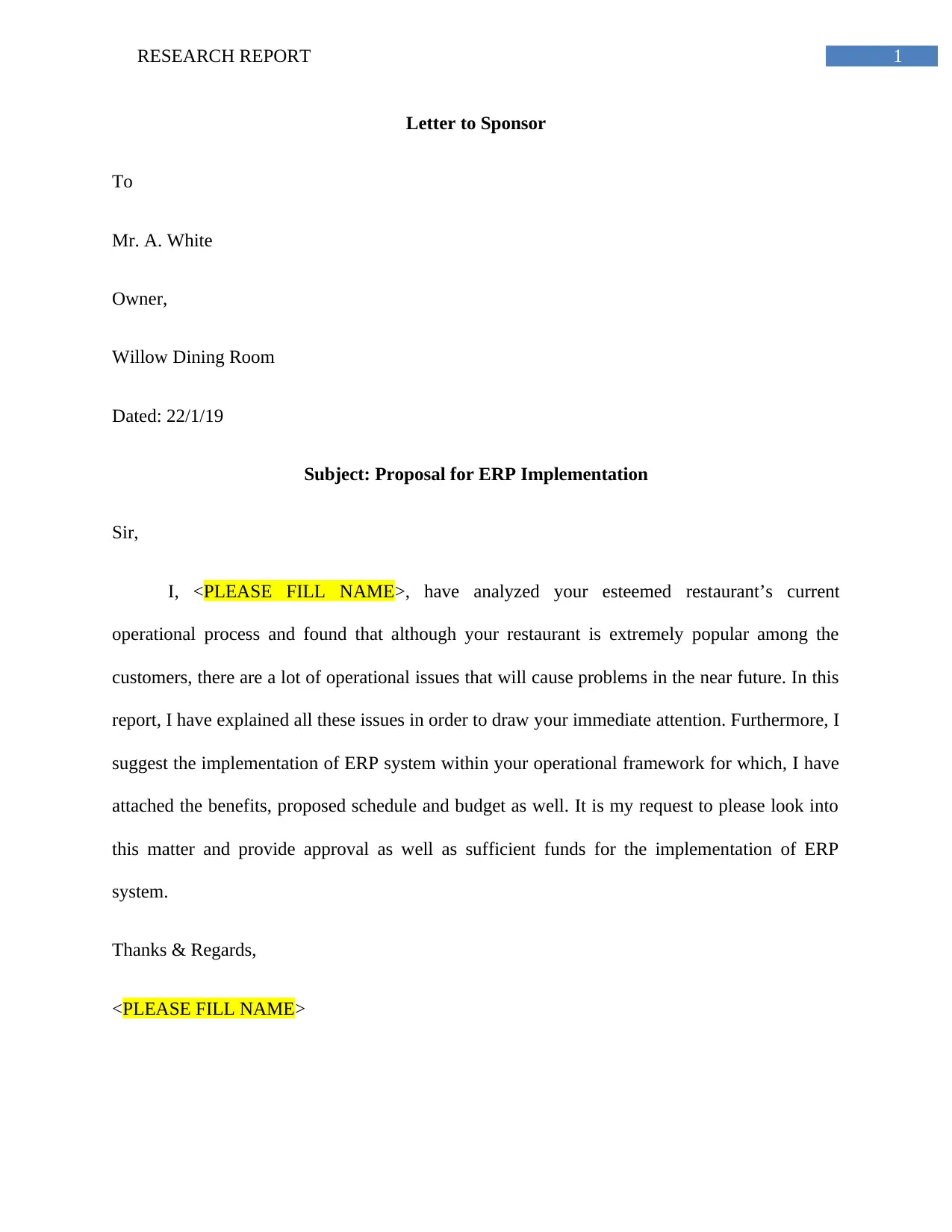
1RESEARCH REPORT
Letter to Sponsor
To
Mr. A. White
Owner,
Willow Dining Room
Dated: 22/1/19
Subject: Proposal for ERP Implementation
Sir,
I, <PLEASE FILL NAME>, have analyzed your esteemed restaurant’s current
operational process and found that although your restaurant is extremely popular among the
customers, there are a lot of operational issues that will cause problems in the near future. In this
report, I have explained all these issues in order to draw your immediate attention. Furthermore, I
suggest the implementation of ERP system within your operational framework for which, I have
attached the benefits, proposed schedule and budget as well. It is my request to please look into
this matter and provide approval as well as sufficient funds for the implementation of ERP
system.
Thanks & Regards,
<PLEASE FILL NAME>
Letter to Sponsor
To
Mr. A. White
Owner,
Willow Dining Room
Dated: 22/1/19
Subject: Proposal for ERP Implementation
Sir,
I, <PLEASE FILL NAME>, have analyzed your esteemed restaurant’s current
operational process and found that although your restaurant is extremely popular among the
customers, there are a lot of operational issues that will cause problems in the near future. In this
report, I have explained all these issues in order to draw your immediate attention. Furthermore, I
suggest the implementation of ERP system within your operational framework for which, I have
attached the benefits, proposed schedule and budget as well. It is my request to please look into
this matter and provide approval as well as sufficient funds for the implementation of ERP
system.
Thanks & Regards,
<PLEASE FILL NAME>
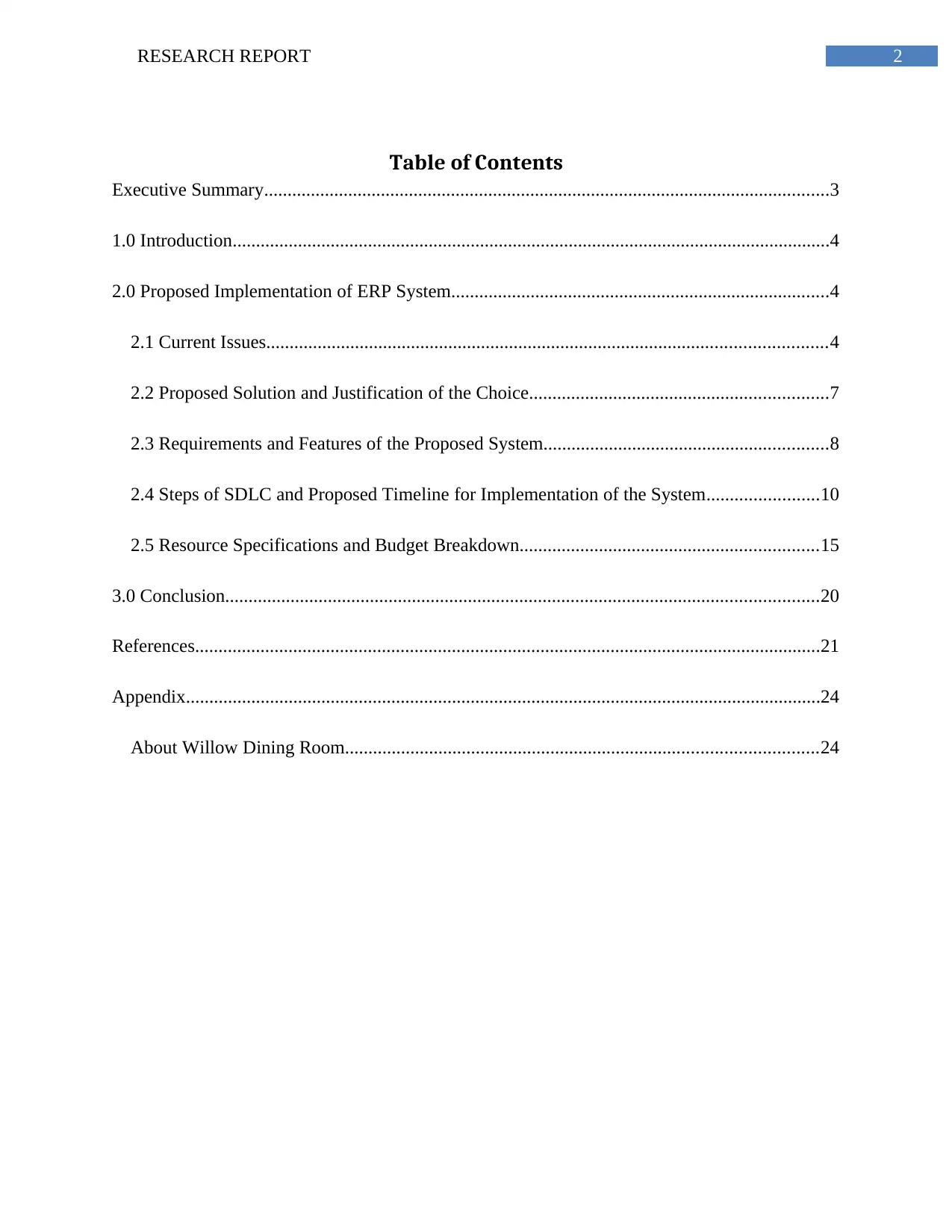
2RESEARCH REPORT
Table of Contents
Executive Summary.........................................................................................................................3
1.0 Introduction................................................................................................................................4
2.0 Proposed Implementation of ERP System.................................................................................4
2.1 Current Issues........................................................................................................................4
2.2 Proposed Solution and Justification of the Choice................................................................7
2.3 Requirements and Features of the Proposed System.............................................................8
2.4 Steps of SDLC and Proposed Timeline for Implementation of the System........................10
2.5 Resource Specifications and Budget Breakdown................................................................15
3.0 Conclusion...............................................................................................................................20
References......................................................................................................................................21
Appendix........................................................................................................................................24
About Willow Dining Room.....................................................................................................24
Table of Contents
Executive Summary.........................................................................................................................3
1.0 Introduction................................................................................................................................4
2.0 Proposed Implementation of ERP System.................................................................................4
2.1 Current Issues........................................................................................................................4
2.2 Proposed Solution and Justification of the Choice................................................................7
2.3 Requirements and Features of the Proposed System.............................................................8
2.4 Steps of SDLC and Proposed Timeline for Implementation of the System........................10
2.5 Resource Specifications and Budget Breakdown................................................................15
3.0 Conclusion...............................................................................................................................20
References......................................................................................................................................21
Appendix........................................................................................................................................24
About Willow Dining Room.....................................................................................................24

3RESEARCH REPORT
Executive Summary
Enterprise Resource Planning (ERP) is a software based business solution that effectively
integrates all the business process and systems of a company into one common functional
system. It provides a wide range of benefits to the company and also reduces the need for
additional human resources as it has multiple functional and automated components. Willow
Dining Room is a restaurant that is currently facing a large number of operational issues and
following the analysis of these issues, the implementation of ERP has been recommended.
Executive Summary
Enterprise Resource Planning (ERP) is a software based business solution that effectively
integrates all the business process and systems of a company into one common functional
system. It provides a wide range of benefits to the company and also reduces the need for
additional human resources as it has multiple functional and automated components. Willow
Dining Room is a restaurant that is currently facing a large number of operational issues and
following the analysis of these issues, the implementation of ERP has been recommended.
Secure Best Marks with AI Grader
Need help grading? Try our AI Grader for instant feedback on your assignments.
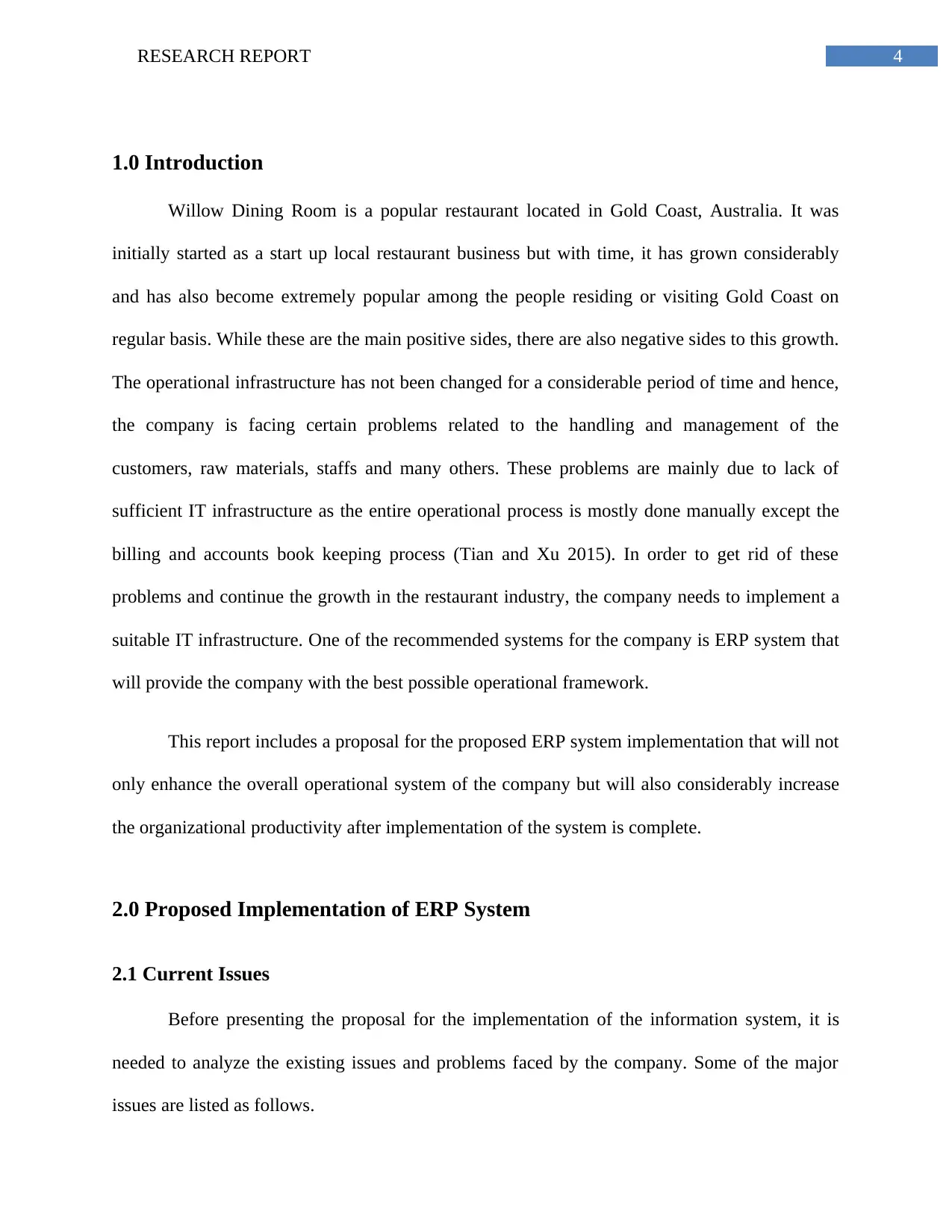
4RESEARCH REPORT
1.0 Introduction
Willow Dining Room is a popular restaurant located in Gold Coast, Australia. It was
initially started as a start up local restaurant business but with time, it has grown considerably
and has also become extremely popular among the people residing or visiting Gold Coast on
regular basis. While these are the main positive sides, there are also negative sides to this growth.
The operational infrastructure has not been changed for a considerable period of time and hence,
the company is facing certain problems related to the handling and management of the
customers, raw materials, staffs and many others. These problems are mainly due to lack of
sufficient IT infrastructure as the entire operational process is mostly done manually except the
billing and accounts book keeping process (Tian and Xu 2015). In order to get rid of these
problems and continue the growth in the restaurant industry, the company needs to implement a
suitable IT infrastructure. One of the recommended systems for the company is ERP system that
will provide the company with the best possible operational framework.
This report includes a proposal for the proposed ERP system implementation that will not
only enhance the overall operational system of the company but will also considerably increase
the organizational productivity after implementation of the system is complete.
2.0 Proposed Implementation of ERP System
2.1 Current Issues
Before presenting the proposal for the implementation of the information system, it is
needed to analyze the existing issues and problems faced by the company. Some of the major
issues are listed as follows.
1.0 Introduction
Willow Dining Room is a popular restaurant located in Gold Coast, Australia. It was
initially started as a start up local restaurant business but with time, it has grown considerably
and has also become extremely popular among the people residing or visiting Gold Coast on
regular basis. While these are the main positive sides, there are also negative sides to this growth.
The operational infrastructure has not been changed for a considerable period of time and hence,
the company is facing certain problems related to the handling and management of the
customers, raw materials, staffs and many others. These problems are mainly due to lack of
sufficient IT infrastructure as the entire operational process is mostly done manually except the
billing and accounts book keeping process (Tian and Xu 2015). In order to get rid of these
problems and continue the growth in the restaurant industry, the company needs to implement a
suitable IT infrastructure. One of the recommended systems for the company is ERP system that
will provide the company with the best possible operational framework.
This report includes a proposal for the proposed ERP system implementation that will not
only enhance the overall operational system of the company but will also considerably increase
the organizational productivity after implementation of the system is complete.
2.0 Proposed Implementation of ERP System
2.1 Current Issues
Before presenting the proposal for the implementation of the information system, it is
needed to analyze the existing issues and problems faced by the company. Some of the major
issues are listed as follows.
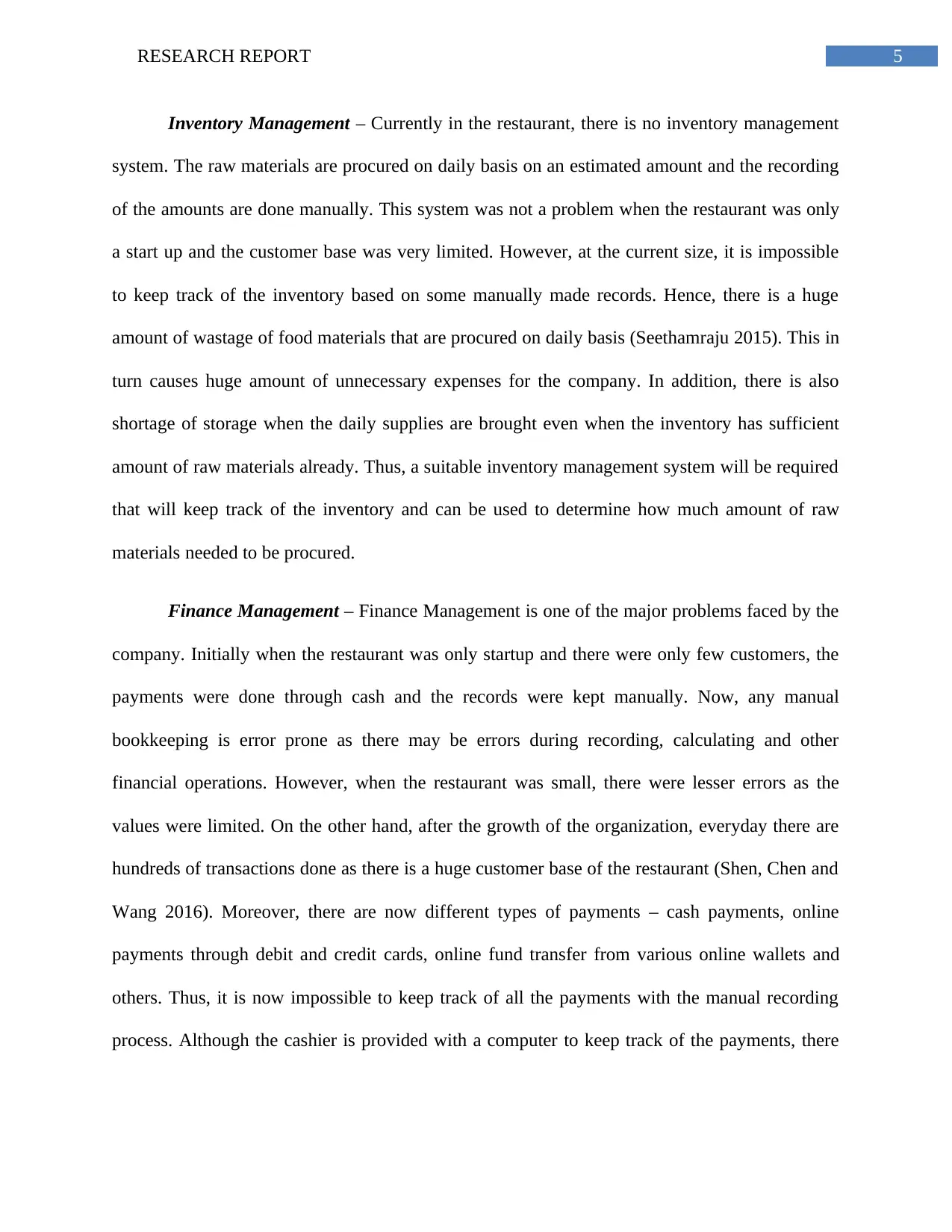
5RESEARCH REPORT
Inventory Management – Currently in the restaurant, there is no inventory management
system. The raw materials are procured on daily basis on an estimated amount and the recording
of the amounts are done manually. This system was not a problem when the restaurant was only
a start up and the customer base was very limited. However, at the current size, it is impossible
to keep track of the inventory based on some manually made records. Hence, there is a huge
amount of wastage of food materials that are procured on daily basis (Seethamraju 2015). This in
turn causes huge amount of unnecessary expenses for the company. In addition, there is also
shortage of storage when the daily supplies are brought even when the inventory has sufficient
amount of raw materials already. Thus, a suitable inventory management system will be required
that will keep track of the inventory and can be used to determine how much amount of raw
materials needed to be procured.
Finance Management – Finance Management is one of the major problems faced by the
company. Initially when the restaurant was only startup and there were only few customers, the
payments were done through cash and the records were kept manually. Now, any manual
bookkeeping is error prone as there may be errors during recording, calculating and other
financial operations. However, when the restaurant was small, there were lesser errors as the
values were limited. On the other hand, after the growth of the organization, everyday there are
hundreds of transactions done as there is a huge customer base of the restaurant (Shen, Chen and
Wang 2016). Moreover, there are now different types of payments – cash payments, online
payments through debit and credit cards, online fund transfer from various online wallets and
others. Thus, it is now impossible to keep track of all the payments with the manual recording
process. Although the cashier is provided with a computer to keep track of the payments, there
Inventory Management – Currently in the restaurant, there is no inventory management
system. The raw materials are procured on daily basis on an estimated amount and the recording
of the amounts are done manually. This system was not a problem when the restaurant was only
a start up and the customer base was very limited. However, at the current size, it is impossible
to keep track of the inventory based on some manually made records. Hence, there is a huge
amount of wastage of food materials that are procured on daily basis (Seethamraju 2015). This in
turn causes huge amount of unnecessary expenses for the company. In addition, there is also
shortage of storage when the daily supplies are brought even when the inventory has sufficient
amount of raw materials already. Thus, a suitable inventory management system will be required
that will keep track of the inventory and can be used to determine how much amount of raw
materials needed to be procured.
Finance Management – Finance Management is one of the major problems faced by the
company. Initially when the restaurant was only startup and there were only few customers, the
payments were done through cash and the records were kept manually. Now, any manual
bookkeeping is error prone as there may be errors during recording, calculating and other
financial operations. However, when the restaurant was small, there were lesser errors as the
values were limited. On the other hand, after the growth of the organization, everyday there are
hundreds of transactions done as there is a huge customer base of the restaurant (Shen, Chen and
Wang 2016). Moreover, there are now different types of payments – cash payments, online
payments through debit and credit cards, online fund transfer from various online wallets and
others. Thus, it is now impossible to keep track of all the payments with the manual recording
process. Although the cashier is provided with a computer to keep track of the payments, there

6RESEARCH REPORT
are frequent errors that lead to major financial losses of the company. Hence, this is one problem
area that needs to solved with the new information system.
Compliance and Safety Regulations – Initially, the company was set up with full trade
license after the management assured compliance with the safety and other regulations that were
active for the restaurant industry. However, with time, these regulations have changed
considerably but the restaurant has not kept track of these updates and changes. Moreover, with a
manual operational system, it is also not possible for the company to update and keep track of the
regular changes in the compliance and safety requirements (Gholamzadeh, Ariani and JaromÃr
2018). On the other hand, if the governing body of the industry finds that the company is not
complying with the safety regulations, the business license may get cancelled. Hence, a suitable
system is required that will keep track of the compliance requirement changes and will alert the
management if the company is not already complying with certain safety regulations.
Staff Management – Currently, there is no specific staff management system in the
restaurant. Once a staff is recruited, it is recorded in a paper document file with a photocopy of
his identity verification card and he is integrated within the set up. However, this is not a proper
solution to staff management as the documents can be easily destroyed and there is no suitable
system for tracking the current and ex-staffs of the organization (Chang et al. 2015). This gives
rise to various issues and problems within the operational set up. Thus, the company needs to
develop a staff management system that will help to keep records of the staffs that in turn will
enable the tracking of performances of the staffs and other operational requirements related to
the staffs.
are frequent errors that lead to major financial losses of the company. Hence, this is one problem
area that needs to solved with the new information system.
Compliance and Safety Regulations – Initially, the company was set up with full trade
license after the management assured compliance with the safety and other regulations that were
active for the restaurant industry. However, with time, these regulations have changed
considerably but the restaurant has not kept track of these updates and changes. Moreover, with a
manual operational system, it is also not possible for the company to update and keep track of the
regular changes in the compliance and safety requirements (Gholamzadeh, Ariani and JaromÃr
2018). On the other hand, if the governing body of the industry finds that the company is not
complying with the safety regulations, the business license may get cancelled. Hence, a suitable
system is required that will keep track of the compliance requirement changes and will alert the
management if the company is not already complying with certain safety regulations.
Staff Management – Currently, there is no specific staff management system in the
restaurant. Once a staff is recruited, it is recorded in a paper document file with a photocopy of
his identity verification card and he is integrated within the set up. However, this is not a proper
solution to staff management as the documents can be easily destroyed and there is no suitable
system for tracking the current and ex-staffs of the organization (Chang et al. 2015). This gives
rise to various issues and problems within the operational set up. Thus, the company needs to
develop a staff management system that will help to keep records of the staffs that in turn will
enable the tracking of performances of the staffs and other operational requirements related to
the staffs.
Paraphrase This Document
Need a fresh take? Get an instant paraphrase of this document with our AI Paraphraser

7RESEARCH REPORT
Proposed Feature – While this is not directly an issue, without a sufficient and efficient
set up, it cannot be implemented realistically. The company has proposed home delivery services
in which the customers can place order for food items from their homes and the company will
deliver the food to their doorsteps. However, since the operations are currently manual, it will
not be possible to track any of the orders and the implementation will fail completely. Thus, a
system is required that will integrate the proposed service within the existing operational
framework of the company.
2.2 Proposed Solution and Justification of the Choice
Analyzing the issues faced by the company, the most suitable solution for the company is
an ERP (Enterprise Resource Planning) System. ERP system is a business process management
software that allows a business organization to integrate all its processes within one common
system. However, the implementation of ERP requires upgraded and efficient IT system with
technically updated hardware and software whereas the company under consideration in this
research does not have any IT set up installed (Antero 2015). Hence, in order to proceed with the
implementation of ERP, the company will need to purchase, install and implement a suitable IT
system and after that, the ERP development and integration can be initiated.
In this case, ERP is selected mainly because this one system will solve all the issues and
problems highlighted under the header. ERP not only provides an extra dimension to the
business operations of the company but will also take care of handling of the internal operations
and requirements. Moreover, ERP system is not a very complex system and can be easily
managed and maintained by a staff member if he is trained for a certain period of time.
Furthermore, in spite of high implementation cost, the maintenance costs of the system are very
low and will also reduce the need for many human resources (Lyytinen and Newman 2015).
Proposed Feature – While this is not directly an issue, without a sufficient and efficient
set up, it cannot be implemented realistically. The company has proposed home delivery services
in which the customers can place order for food items from their homes and the company will
deliver the food to their doorsteps. However, since the operations are currently manual, it will
not be possible to track any of the orders and the implementation will fail completely. Thus, a
system is required that will integrate the proposed service within the existing operational
framework of the company.
2.2 Proposed Solution and Justification of the Choice
Analyzing the issues faced by the company, the most suitable solution for the company is
an ERP (Enterprise Resource Planning) System. ERP system is a business process management
software that allows a business organization to integrate all its processes within one common
system. However, the implementation of ERP requires upgraded and efficient IT system with
technically updated hardware and software whereas the company under consideration in this
research does not have any IT set up installed (Antero 2015). Hence, in order to proceed with the
implementation of ERP, the company will need to purchase, install and implement a suitable IT
system and after that, the ERP development and integration can be initiated.
In this case, ERP is selected mainly because this one system will solve all the issues and
problems highlighted under the header. ERP not only provides an extra dimension to the
business operations of the company but will also take care of handling of the internal operations
and requirements. Moreover, ERP system is not a very complex system and can be easily
managed and maintained by a staff member if he is trained for a certain period of time.
Furthermore, in spite of high implementation cost, the maintenance costs of the system are very
low and will also reduce the need for many human resources (Lyytinen and Newman 2015).
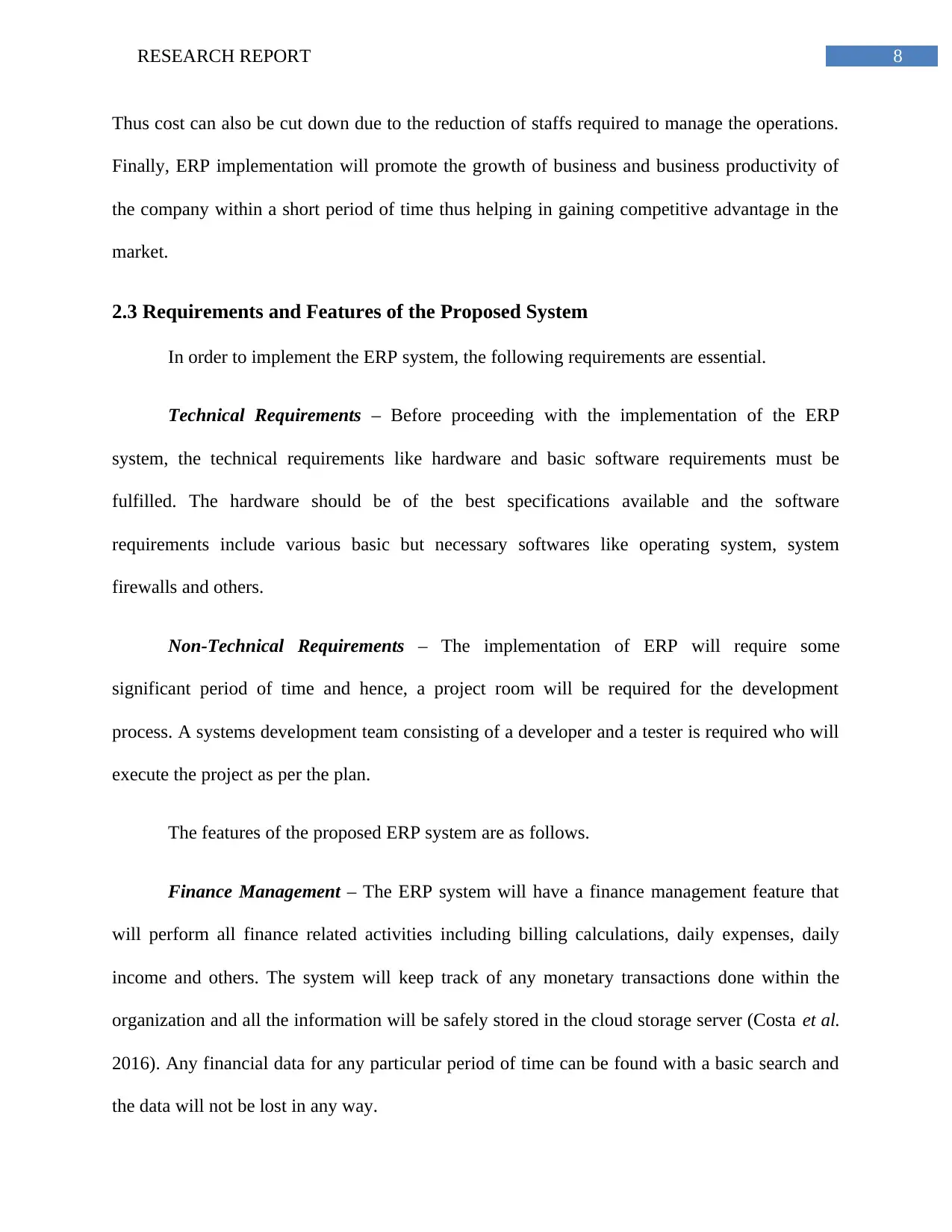
8RESEARCH REPORT
Thus cost can also be cut down due to the reduction of staffs required to manage the operations.
Finally, ERP implementation will promote the growth of business and business productivity of
the company within a short period of time thus helping in gaining competitive advantage in the
market.
2.3 Requirements and Features of the Proposed System
In order to implement the ERP system, the following requirements are essential.
Technical Requirements – Before proceeding with the implementation of the ERP
system, the technical requirements like hardware and basic software requirements must be
fulfilled. The hardware should be of the best specifications available and the software
requirements include various basic but necessary softwares like operating system, system
firewalls and others.
Non-Technical Requirements – The implementation of ERP will require some
significant period of time and hence, a project room will be required for the development
process. A systems development team consisting of a developer and a tester is required who will
execute the project as per the plan.
The features of the proposed ERP system are as follows.
Finance Management – The ERP system will have a finance management feature that
will perform all finance related activities including billing calculations, daily expenses, daily
income and others. The system will keep track of any monetary transactions done within the
organization and all the information will be safely stored in the cloud storage server (Costa et al.
2016). Any financial data for any particular period of time can be found with a basic search and
the data will not be lost in any way.
Thus cost can also be cut down due to the reduction of staffs required to manage the operations.
Finally, ERP implementation will promote the growth of business and business productivity of
the company within a short period of time thus helping in gaining competitive advantage in the
market.
2.3 Requirements and Features of the Proposed System
In order to implement the ERP system, the following requirements are essential.
Technical Requirements – Before proceeding with the implementation of the ERP
system, the technical requirements like hardware and basic software requirements must be
fulfilled. The hardware should be of the best specifications available and the software
requirements include various basic but necessary softwares like operating system, system
firewalls and others.
Non-Technical Requirements – The implementation of ERP will require some
significant period of time and hence, a project room will be required for the development
process. A systems development team consisting of a developer and a tester is required who will
execute the project as per the plan.
The features of the proposed ERP system are as follows.
Finance Management – The ERP system will have a finance management feature that
will perform all finance related activities including billing calculations, daily expenses, daily
income and others. The system will keep track of any monetary transactions done within the
organization and all the information will be safely stored in the cloud storage server (Costa et al.
2016). Any financial data for any particular period of time can be found with a basic search and
the data will not be lost in any way.

9RESEARCH REPORT
Inventory Management – The ERP system will have an effective and efficient inventory
management system that will keep track of the stock levels in the inventory on daily basis. There
will not be any more wastage of materials as the stock levels will be updated in the inventory and
before purchasing new materials, the procurement staff can check the inventory stock levels in
the system and then make purchase decisions (Baskerville, Pawlowski and McLean 2016). Thus,
there will be no chances for extra or low stock levels for the materials in the inventory. This will
also enable the company to reduce costs faced due to resource wastage.
Compliances – The ERP system is hosted online and it will keep track of all the updated
compliance and safety requirements. It will also match the same with the current complaints and
safety standards followed by the company and will alert the management if it finds some
compliance and safety requirements are not followed.
Staff Management – The ERP system will also provide an effective Staff Management
System that will help the management to keep track of all the staffs including their personal
details, performances and other relevant details. The cloud component of the ERP system will
store all the personal and other details of the staffs that can be used as reference by the
management whenever required.
Home Delivery System – The company can also go ahead with the proposed home
delivery system after the implementation of ERP. Using the business portal of ERP, the company
can create a food delivery website through which the customers can order food. All the orders
will be recorded by the ERP cloud and it will be much easier for the staffs to check out the orders
based on the priority and deliver the food accordingly. Furthermore, there will not be any
Inventory Management – The ERP system will have an effective and efficient inventory
management system that will keep track of the stock levels in the inventory on daily basis. There
will not be any more wastage of materials as the stock levels will be updated in the inventory and
before purchasing new materials, the procurement staff can check the inventory stock levels in
the system and then make purchase decisions (Baskerville, Pawlowski and McLean 2016). Thus,
there will be no chances for extra or low stock levels for the materials in the inventory. This will
also enable the company to reduce costs faced due to resource wastage.
Compliances – The ERP system is hosted online and it will keep track of all the updated
compliance and safety requirements. It will also match the same with the current complaints and
safety standards followed by the company and will alert the management if it finds some
compliance and safety requirements are not followed.
Staff Management – The ERP system will also provide an effective Staff Management
System that will help the management to keep track of all the staffs including their personal
details, performances and other relevant details. The cloud component of the ERP system will
store all the personal and other details of the staffs that can be used as reference by the
management whenever required.
Home Delivery System – The company can also go ahead with the proposed home
delivery system after the implementation of ERP. Using the business portal of ERP, the company
can create a food delivery website through which the customers can order food. All the orders
will be recorded by the ERP cloud and it will be much easier for the staffs to check out the orders
based on the priority and deliver the food accordingly. Furthermore, there will not be any
Secure Best Marks with AI Grader
Need help grading? Try our AI Grader for instant feedback on your assignments.
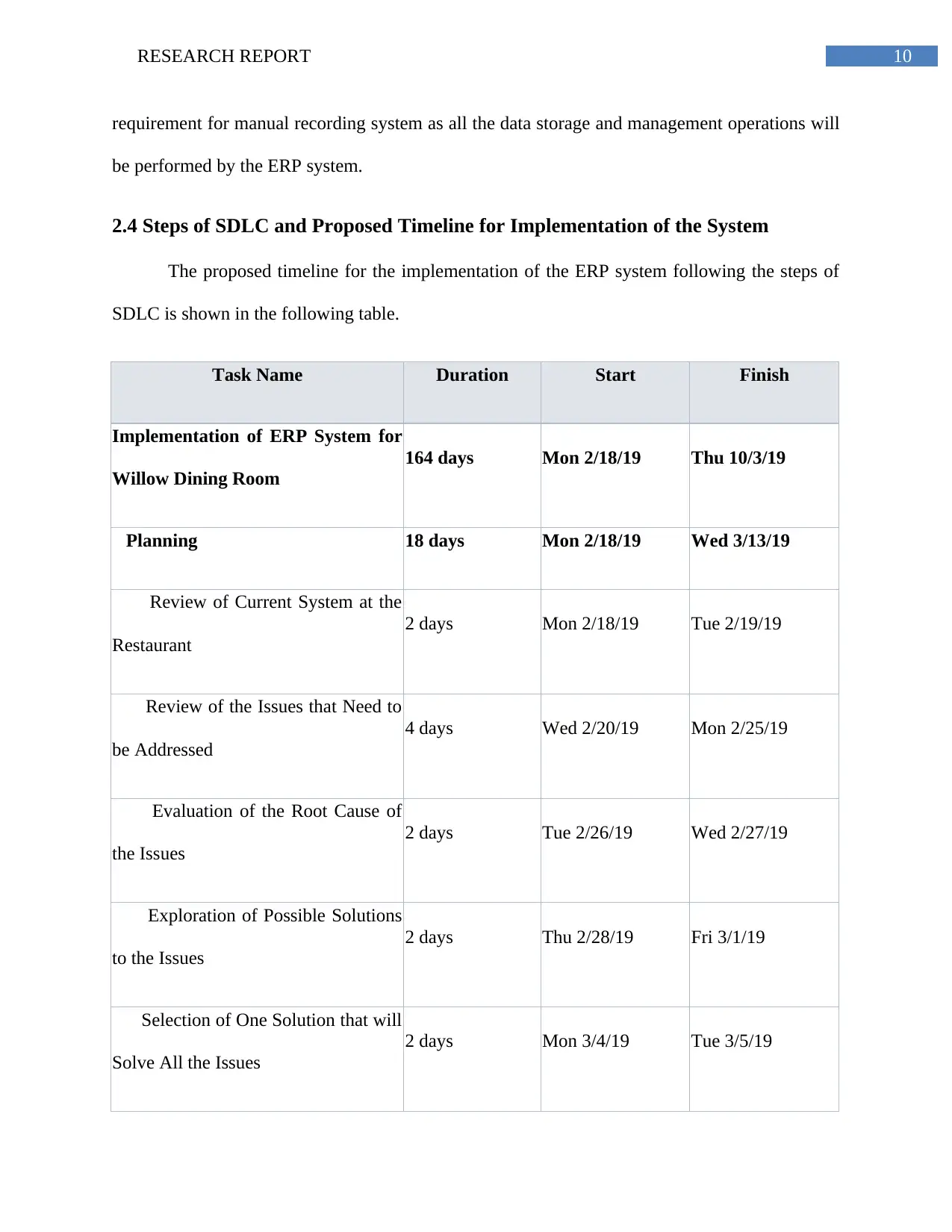
10RESEARCH REPORT
requirement for manual recording system as all the data storage and management operations will
be performed by the ERP system.
2.4 Steps of SDLC and Proposed Timeline for Implementation of the System
The proposed timeline for the implementation of the ERP system following the steps of
SDLC is shown in the following table.
Task Name Duration Start Finish
Implementation of ERP System for
Willow Dining Room
164 days Mon 2/18/19 Thu 10/3/19
Planning 18 days Mon 2/18/19 Wed 3/13/19
Review of Current System at the
Restaurant
2 days Mon 2/18/19 Tue 2/19/19
Review of the Issues that Need to
be Addressed
4 days Wed 2/20/19 Mon 2/25/19
Evaluation of the Root Cause of
the Issues
2 days Tue 2/26/19 Wed 2/27/19
Exploration of Possible Solutions
to the Issues
2 days Thu 2/28/19 Fri 3/1/19
Selection of One Solution that will
Solve All the Issues
2 days Mon 3/4/19 Tue 3/5/19
requirement for manual recording system as all the data storage and management operations will
be performed by the ERP system.
2.4 Steps of SDLC and Proposed Timeline for Implementation of the System
The proposed timeline for the implementation of the ERP system following the steps of
SDLC is shown in the following table.
Task Name Duration Start Finish
Implementation of ERP System for
Willow Dining Room
164 days Mon 2/18/19 Thu 10/3/19
Planning 18 days Mon 2/18/19 Wed 3/13/19
Review of Current System at the
Restaurant
2 days Mon 2/18/19 Tue 2/19/19
Review of the Issues that Need to
be Addressed
4 days Wed 2/20/19 Mon 2/25/19
Evaluation of the Root Cause of
the Issues
2 days Tue 2/26/19 Wed 2/27/19
Exploration of Possible Solutions
to the Issues
2 days Thu 2/28/19 Fri 3/1/19
Selection of One Solution that will
Solve All the Issues
2 days Mon 3/4/19 Tue 3/5/19
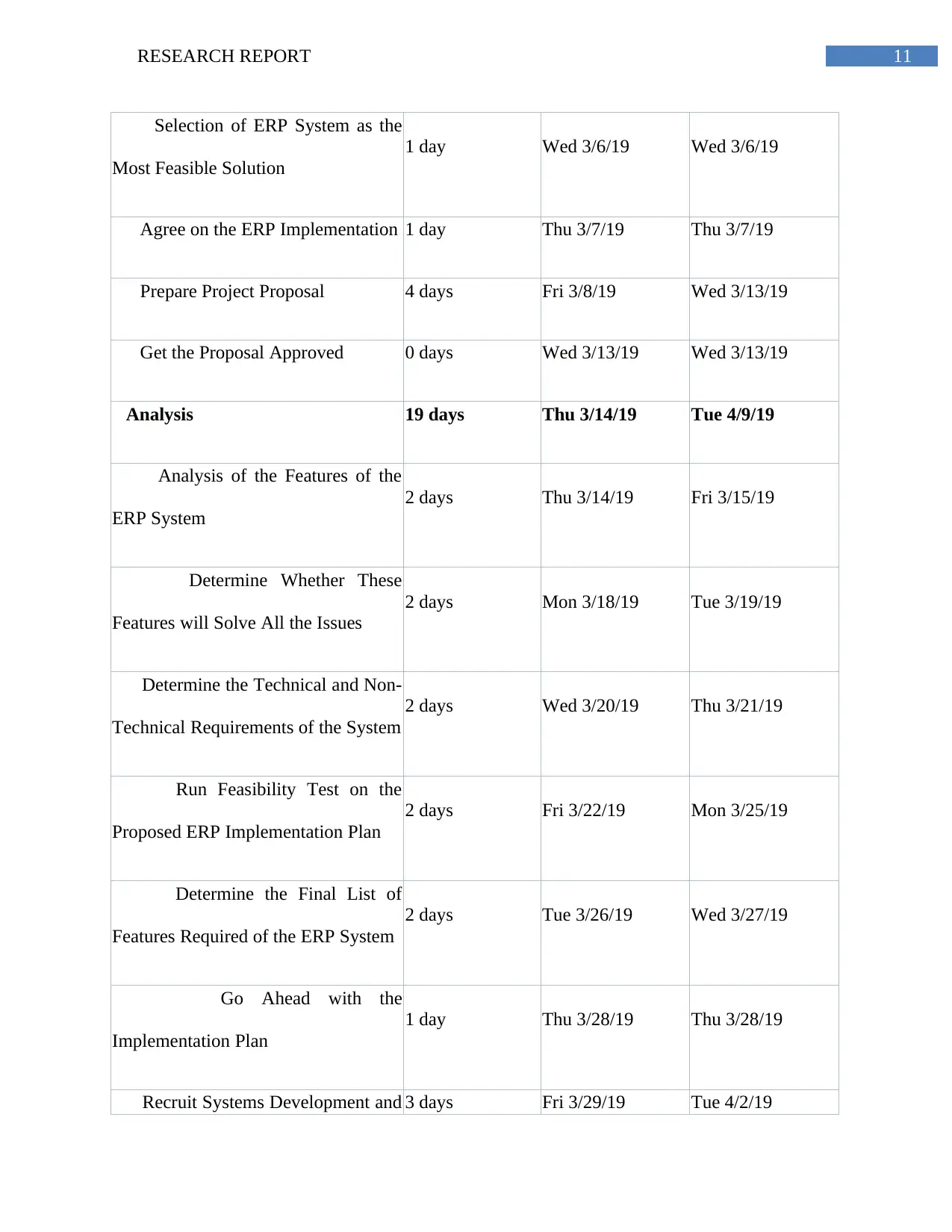
11RESEARCH REPORT
Selection of ERP System as the
Most Feasible Solution
1 day Wed 3/6/19 Wed 3/6/19
Agree on the ERP Implementation 1 day Thu 3/7/19 Thu 3/7/19
Prepare Project Proposal 4 days Fri 3/8/19 Wed 3/13/19
Get the Proposal Approved 0 days Wed 3/13/19 Wed 3/13/19
Analysis 19 days Thu 3/14/19 Tue 4/9/19
Analysis of the Features of the
ERP System
2 days Thu 3/14/19 Fri 3/15/19
Determine Whether These
Features will Solve All the Issues
2 days Mon 3/18/19 Tue 3/19/19
Determine the Technical and Non-
Technical Requirements of the System
2 days Wed 3/20/19 Thu 3/21/19
Run Feasibility Test on the
Proposed ERP Implementation Plan
2 days Fri 3/22/19 Mon 3/25/19
Determine the Final List of
Features Required of the ERP System
2 days Tue 3/26/19 Wed 3/27/19
Go Ahead with the
Implementation Plan
1 day Thu 3/28/19 Thu 3/28/19
Recruit Systems Development and 3 days Fri 3/29/19 Tue 4/2/19
Selection of ERP System as the
Most Feasible Solution
1 day Wed 3/6/19 Wed 3/6/19
Agree on the ERP Implementation 1 day Thu 3/7/19 Thu 3/7/19
Prepare Project Proposal 4 days Fri 3/8/19 Wed 3/13/19
Get the Proposal Approved 0 days Wed 3/13/19 Wed 3/13/19
Analysis 19 days Thu 3/14/19 Tue 4/9/19
Analysis of the Features of the
ERP System
2 days Thu 3/14/19 Fri 3/15/19
Determine Whether These
Features will Solve All the Issues
2 days Mon 3/18/19 Tue 3/19/19
Determine the Technical and Non-
Technical Requirements of the System
2 days Wed 3/20/19 Thu 3/21/19
Run Feasibility Test on the
Proposed ERP Implementation Plan
2 days Fri 3/22/19 Mon 3/25/19
Determine the Final List of
Features Required of the ERP System
2 days Tue 3/26/19 Wed 3/27/19
Go Ahead with the
Implementation Plan
1 day Thu 3/28/19 Thu 3/28/19
Recruit Systems Development and 3 days Fri 3/29/19 Tue 4/2/19
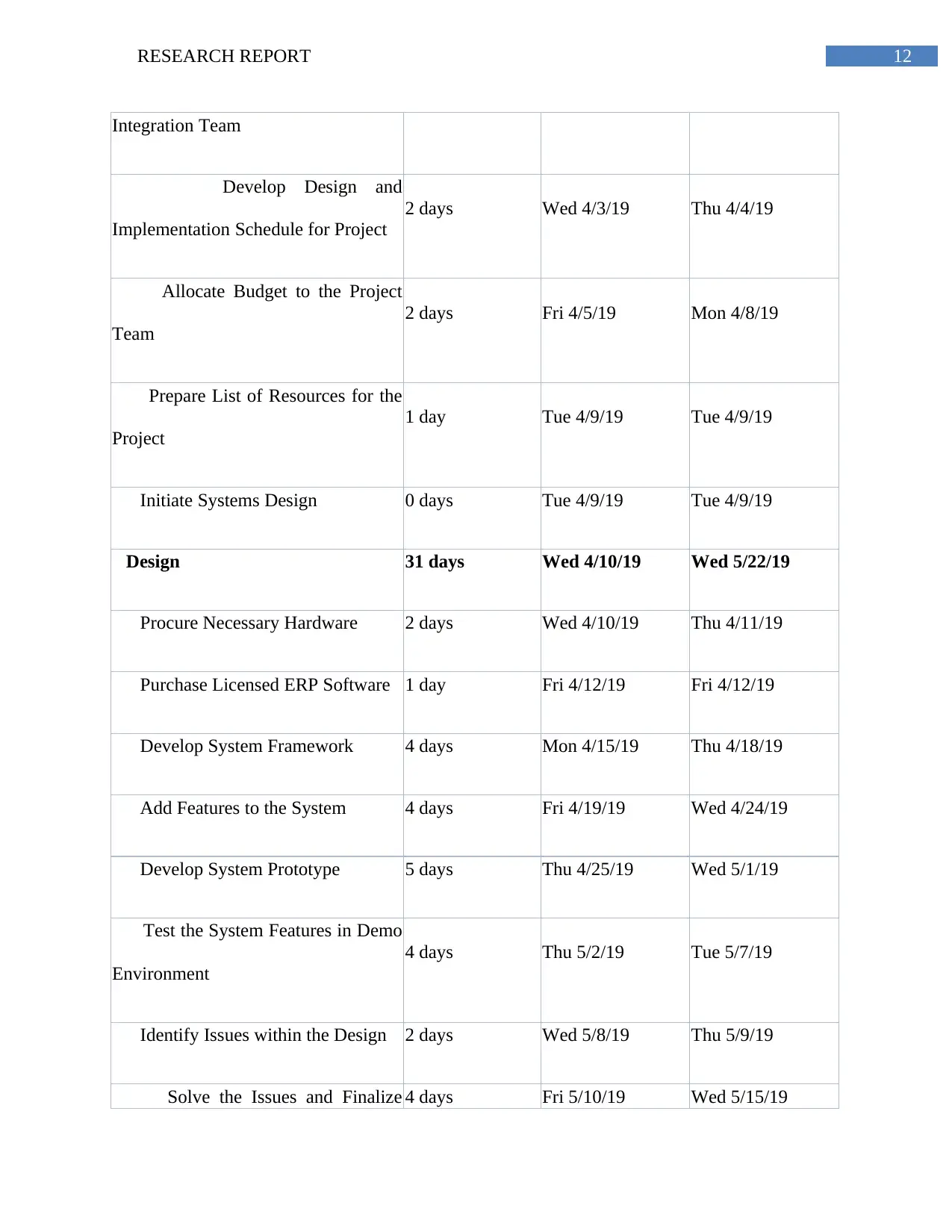
12RESEARCH REPORT
Integration Team
Develop Design and
Implementation Schedule for Project
2 days Wed 4/3/19 Thu 4/4/19
Allocate Budget to the Project
Team
2 days Fri 4/5/19 Mon 4/8/19
Prepare List of Resources for the
Project
1 day Tue 4/9/19 Tue 4/9/19
Initiate Systems Design 0 days Tue 4/9/19 Tue 4/9/19
Design 31 days Wed 4/10/19 Wed 5/22/19
Procure Necessary Hardware 2 days Wed 4/10/19 Thu 4/11/19
Purchase Licensed ERP Software 1 day Fri 4/12/19 Fri 4/12/19
Develop System Framework 4 days Mon 4/15/19 Thu 4/18/19
Add Features to the System 4 days Fri 4/19/19 Wed 4/24/19
Develop System Prototype 5 days Thu 4/25/19 Wed 5/1/19
Test the System Features in Demo
Environment
4 days Thu 5/2/19 Tue 5/7/19
Identify Issues within the Design 2 days Wed 5/8/19 Thu 5/9/19
Solve the Issues and Finalize 4 days Fri 5/10/19 Wed 5/15/19
Integration Team
Develop Design and
Implementation Schedule for Project
2 days Wed 4/3/19 Thu 4/4/19
Allocate Budget to the Project
Team
2 days Fri 4/5/19 Mon 4/8/19
Prepare List of Resources for the
Project
1 day Tue 4/9/19 Tue 4/9/19
Initiate Systems Design 0 days Tue 4/9/19 Tue 4/9/19
Design 31 days Wed 4/10/19 Wed 5/22/19
Procure Necessary Hardware 2 days Wed 4/10/19 Thu 4/11/19
Purchase Licensed ERP Software 1 day Fri 4/12/19 Fri 4/12/19
Develop System Framework 4 days Mon 4/15/19 Thu 4/18/19
Add Features to the System 4 days Fri 4/19/19 Wed 4/24/19
Develop System Prototype 5 days Thu 4/25/19 Wed 5/1/19
Test the System Features in Demo
Environment
4 days Thu 5/2/19 Tue 5/7/19
Identify Issues within the Design 2 days Wed 5/8/19 Thu 5/9/19
Solve the Issues and Finalize 4 days Fri 5/10/19 Wed 5/15/19
Paraphrase This Document
Need a fresh take? Get an instant paraphrase of this document with our AI Paraphraser
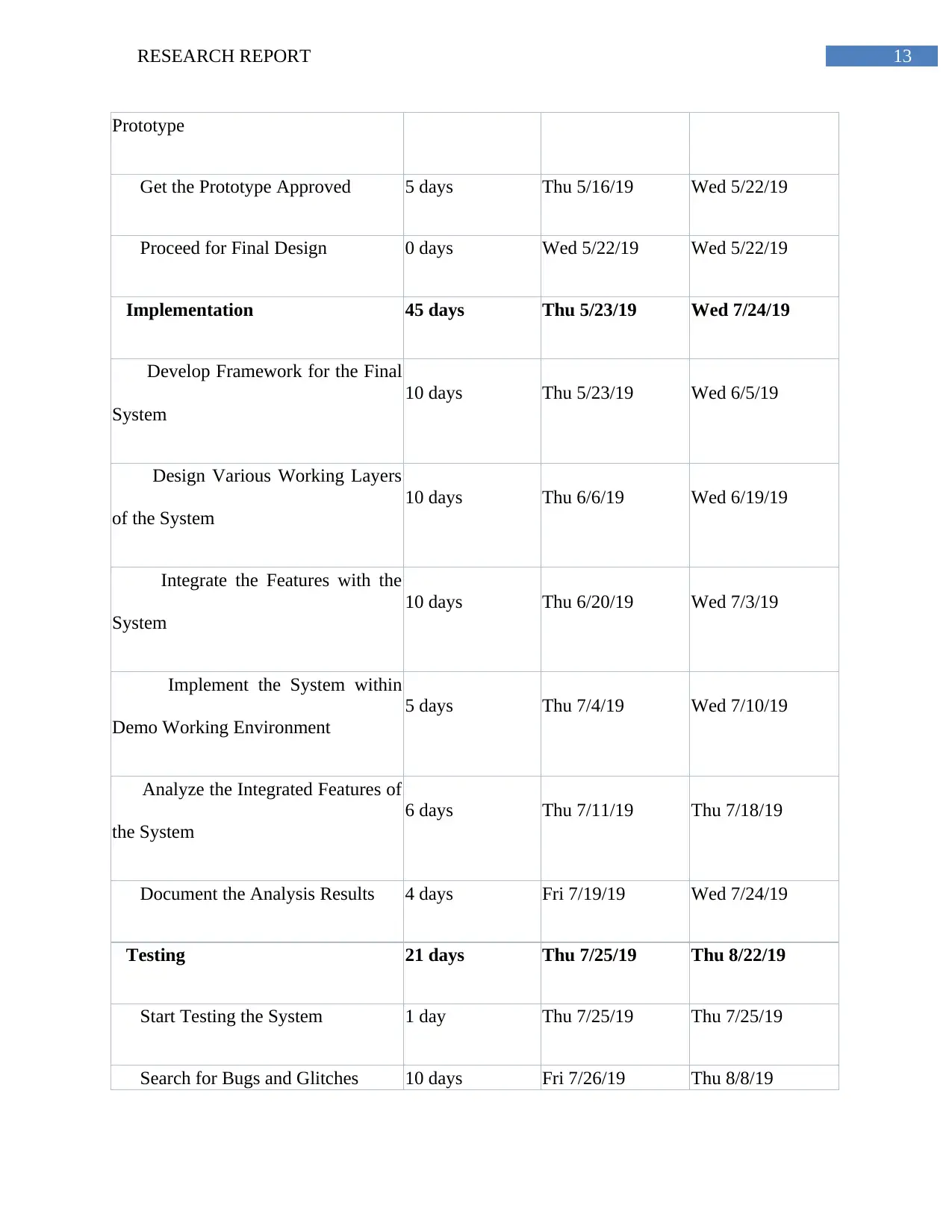
13RESEARCH REPORT
Prototype
Get the Prototype Approved 5 days Thu 5/16/19 Wed 5/22/19
Proceed for Final Design 0 days Wed 5/22/19 Wed 5/22/19
Implementation 45 days Thu 5/23/19 Wed 7/24/19
Develop Framework for the Final
System
10 days Thu 5/23/19 Wed 6/5/19
Design Various Working Layers
of the System
10 days Thu 6/6/19 Wed 6/19/19
Integrate the Features with the
System
10 days Thu 6/20/19 Wed 7/3/19
Implement the System within
Demo Working Environment
5 days Thu 7/4/19 Wed 7/10/19
Analyze the Integrated Features of
the System
6 days Thu 7/11/19 Thu 7/18/19
Document the Analysis Results 4 days Fri 7/19/19 Wed 7/24/19
Testing 21 days Thu 7/25/19 Thu 8/22/19
Start Testing the System 1 day Thu 7/25/19 Thu 7/25/19
Search for Bugs and Glitches 10 days Fri 7/26/19 Thu 8/8/19
Prototype
Get the Prototype Approved 5 days Thu 5/16/19 Wed 5/22/19
Proceed for Final Design 0 days Wed 5/22/19 Wed 5/22/19
Implementation 45 days Thu 5/23/19 Wed 7/24/19
Develop Framework for the Final
System
10 days Thu 5/23/19 Wed 6/5/19
Design Various Working Layers
of the System
10 days Thu 6/6/19 Wed 6/19/19
Integrate the Features with the
System
10 days Thu 6/20/19 Wed 7/3/19
Implement the System within
Demo Working Environment
5 days Thu 7/4/19 Wed 7/10/19
Analyze the Integrated Features of
the System
6 days Thu 7/11/19 Thu 7/18/19
Document the Analysis Results 4 days Fri 7/19/19 Wed 7/24/19
Testing 21 days Thu 7/25/19 Thu 8/22/19
Start Testing the System 1 day Thu 7/25/19 Thu 7/25/19
Search for Bugs and Glitches 10 days Fri 7/26/19 Thu 8/8/19
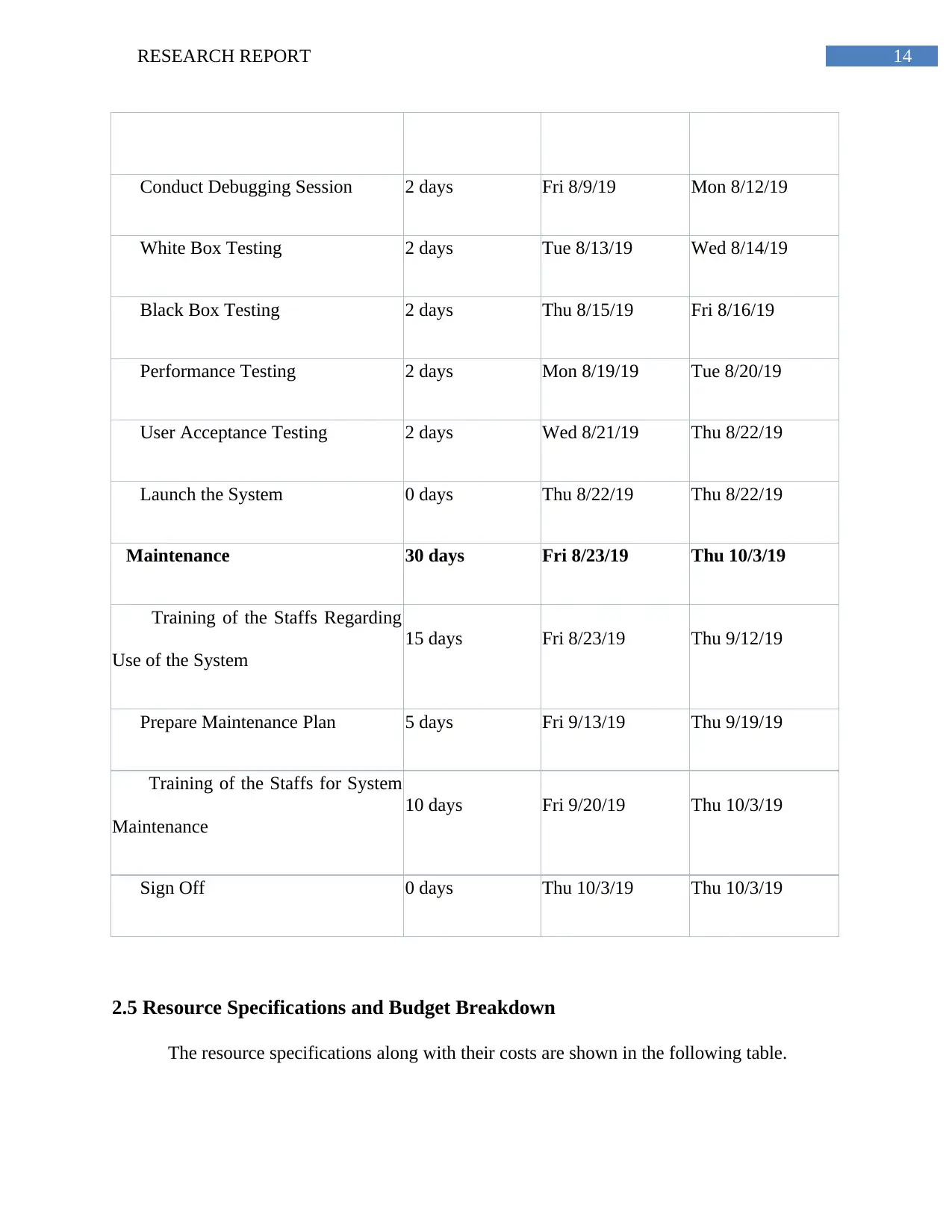
14RESEARCH REPORT
Conduct Debugging Session 2 days Fri 8/9/19 Mon 8/12/19
White Box Testing 2 days Tue 8/13/19 Wed 8/14/19
Black Box Testing 2 days Thu 8/15/19 Fri 8/16/19
Performance Testing 2 days Mon 8/19/19 Tue 8/20/19
User Acceptance Testing 2 days Wed 8/21/19 Thu 8/22/19
Launch the System 0 days Thu 8/22/19 Thu 8/22/19
Maintenance 30 days Fri 8/23/19 Thu 10/3/19
Training of the Staffs Regarding
Use of the System
15 days Fri 8/23/19 Thu 9/12/19
Prepare Maintenance Plan 5 days Fri 9/13/19 Thu 9/19/19
Training of the Staffs for System
Maintenance
10 days Fri 9/20/19 Thu 10/3/19
Sign Off 0 days Thu 10/3/19 Thu 10/3/19
2.5 Resource Specifications and Budget Breakdown
The resource specifications along with their costs are shown in the following table.
Conduct Debugging Session 2 days Fri 8/9/19 Mon 8/12/19
White Box Testing 2 days Tue 8/13/19 Wed 8/14/19
Black Box Testing 2 days Thu 8/15/19 Fri 8/16/19
Performance Testing 2 days Mon 8/19/19 Tue 8/20/19
User Acceptance Testing 2 days Wed 8/21/19 Thu 8/22/19
Launch the System 0 days Thu 8/22/19 Thu 8/22/19
Maintenance 30 days Fri 8/23/19 Thu 10/3/19
Training of the Staffs Regarding
Use of the System
15 days Fri 8/23/19 Thu 9/12/19
Prepare Maintenance Plan 5 days Fri 9/13/19 Thu 9/19/19
Training of the Staffs for System
Maintenance
10 days Fri 9/20/19 Thu 10/3/19
Sign Off 0 days Thu 10/3/19 Thu 10/3/19
2.5 Resource Specifications and Budget Breakdown
The resource specifications along with their costs are shown in the following table.
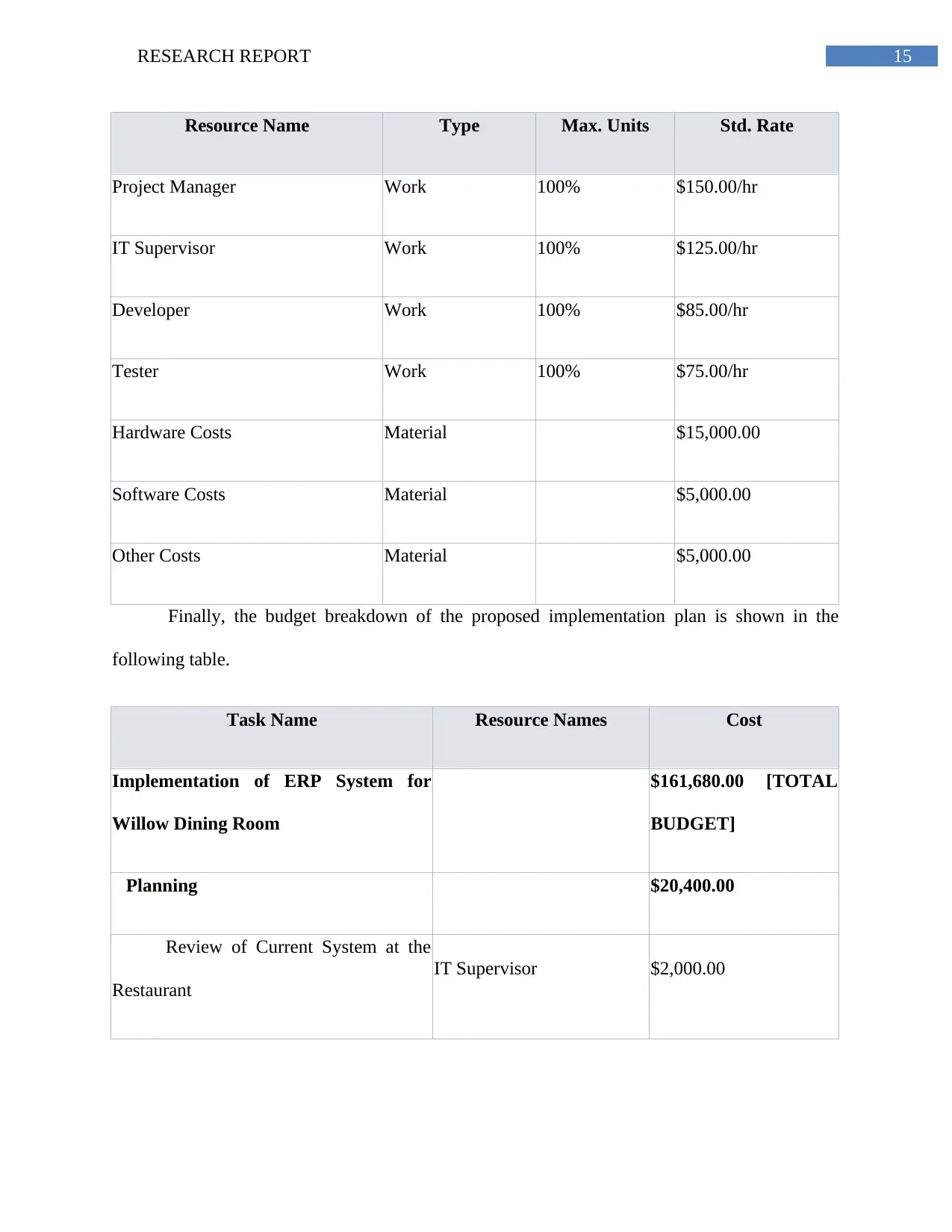
15RESEARCH REPORT
Resource Name Type Max. Units Std. Rate
Project Manager Work 100% $150.00/hr
IT Supervisor Work 100% $125.00/hr
Developer Work 100% $85.00/hr
Tester Work 100% $75.00/hr
Hardware Costs Material $15,000.00
Software Costs Material $5,000.00
Other Costs Material $5,000.00
Finally, the budget breakdown of the proposed implementation plan is shown in the
following table.
Task Name Resource Names Cost
Implementation of ERP System for
Willow Dining Room
$161,680.00 [TOTAL
BUDGET]
Planning $20,400.00
Review of Current System at the
Restaurant
IT Supervisor $2,000.00
Resource Name Type Max. Units Std. Rate
Project Manager Work 100% $150.00/hr
IT Supervisor Work 100% $125.00/hr
Developer Work 100% $85.00/hr
Tester Work 100% $75.00/hr
Hardware Costs Material $15,000.00
Software Costs Material $5,000.00
Other Costs Material $5,000.00
Finally, the budget breakdown of the proposed implementation plan is shown in the
following table.
Task Name Resource Names Cost
Implementation of ERP System for
Willow Dining Room
$161,680.00 [TOTAL
BUDGET]
Planning $20,400.00
Review of Current System at the
Restaurant
IT Supervisor $2,000.00
Secure Best Marks with AI Grader
Need help grading? Try our AI Grader for instant feedback on your assignments.
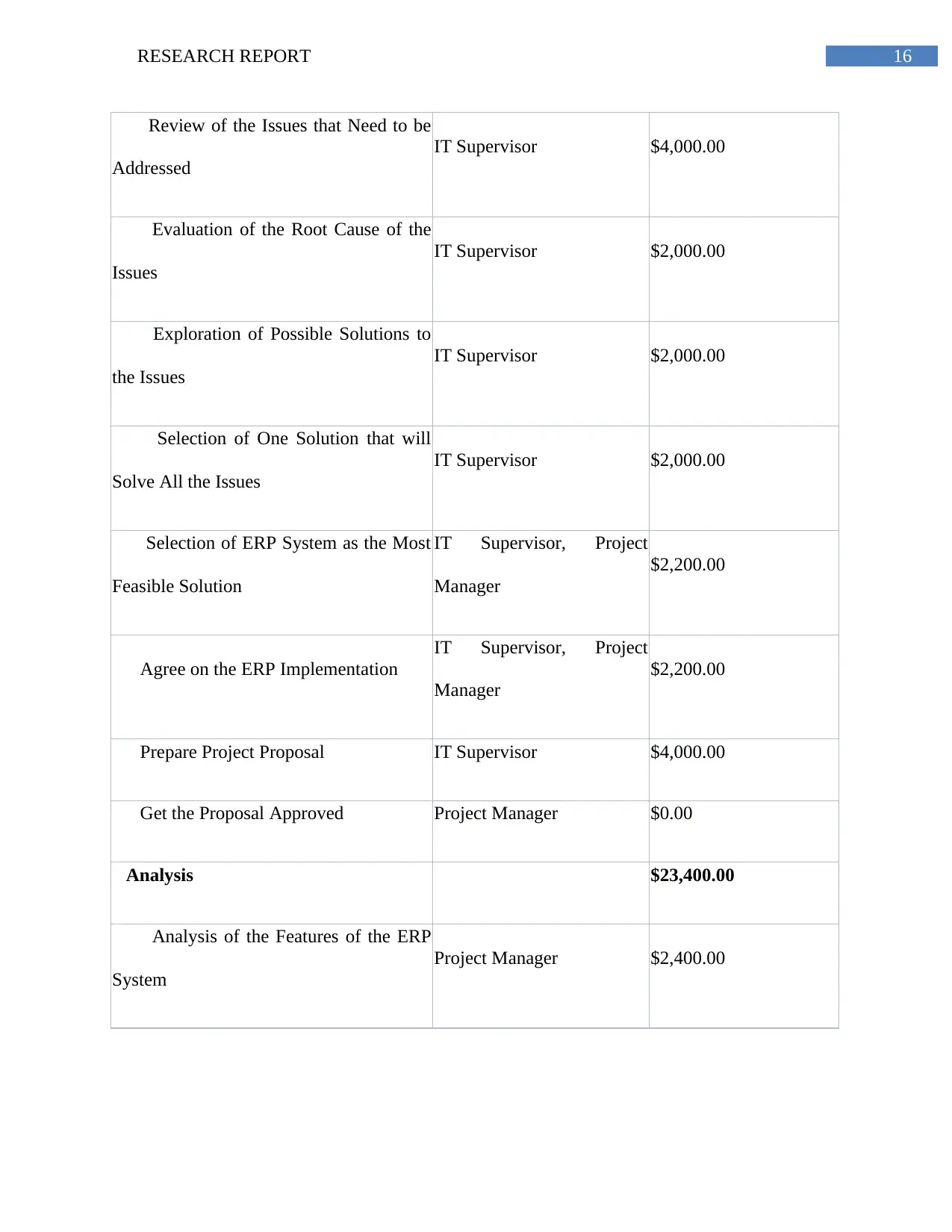
16RESEARCH REPORT
Review of the Issues that Need to be
Addressed
IT Supervisor $4,000.00
Evaluation of the Root Cause of the
Issues
IT Supervisor $2,000.00
Exploration of Possible Solutions to
the Issues
IT Supervisor $2,000.00
Selection of One Solution that will
Solve All the Issues
IT Supervisor $2,000.00
Selection of ERP System as the Most
Feasible Solution
IT Supervisor, Project
Manager
$2,200.00
Agree on the ERP Implementation
IT Supervisor, Project
Manager
$2,200.00
Prepare Project Proposal IT Supervisor $4,000.00
Get the Proposal Approved Project Manager $0.00
Analysis $23,400.00
Analysis of the Features of the ERP
System
Project Manager $2,400.00
Review of the Issues that Need to be
Addressed
IT Supervisor $4,000.00
Evaluation of the Root Cause of the
Issues
IT Supervisor $2,000.00
Exploration of Possible Solutions to
the Issues
IT Supervisor $2,000.00
Selection of One Solution that will
Solve All the Issues
IT Supervisor $2,000.00
Selection of ERP System as the Most
Feasible Solution
IT Supervisor, Project
Manager
$2,200.00
Agree on the ERP Implementation
IT Supervisor, Project
Manager
$2,200.00
Prepare Project Proposal IT Supervisor $4,000.00
Get the Proposal Approved Project Manager $0.00
Analysis $23,400.00
Analysis of the Features of the ERP
System
Project Manager $2,400.00

17RESEARCH REPORT
Determine Whether These Features
will Solve All the Issues
Project Manager $2,400.00
Determine the Technical and Non-
Technical Requirements of the System
IT Supervisor, Project
Manager
$4,400.00
Run Feasibility Test on the Proposed
ERP Implementation Plan
IT Supervisor $2,000.00
Determine the Final List of Features
Required of the ERP System
IT Supervisor $2,000.00
Go Ahead with the Implementation
Plan
Project Manager $1,200.00
Recruit Systems Development and
Integration Team
Project Manager $3,600.00
Develop Design and Implementation
Schedule for Project
IT Supervisor $2,000.00
Allocate Budget to the Project Team Project Manager $2,400.00
Prepare List of Resources for the
Project
IT Supervisor $1,000.00
Initiate Systems Design
Developer, Tester, Other
Costs[0]
$0.00
Determine Whether These Features
will Solve All the Issues
Project Manager $2,400.00
Determine the Technical and Non-
Technical Requirements of the System
IT Supervisor, Project
Manager
$4,400.00
Run Feasibility Test on the Proposed
ERP Implementation Plan
IT Supervisor $2,000.00
Determine the Final List of Features
Required of the ERP System
IT Supervisor $2,000.00
Go Ahead with the Implementation
Plan
Project Manager $1,200.00
Recruit Systems Development and
Integration Team
Project Manager $3,600.00
Develop Design and Implementation
Schedule for Project
IT Supervisor $2,000.00
Allocate Budget to the Project Team Project Manager $2,400.00
Prepare List of Resources for the
Project
IT Supervisor $1,000.00
Initiate Systems Design
Developer, Tester, Other
Costs[0]
$0.00
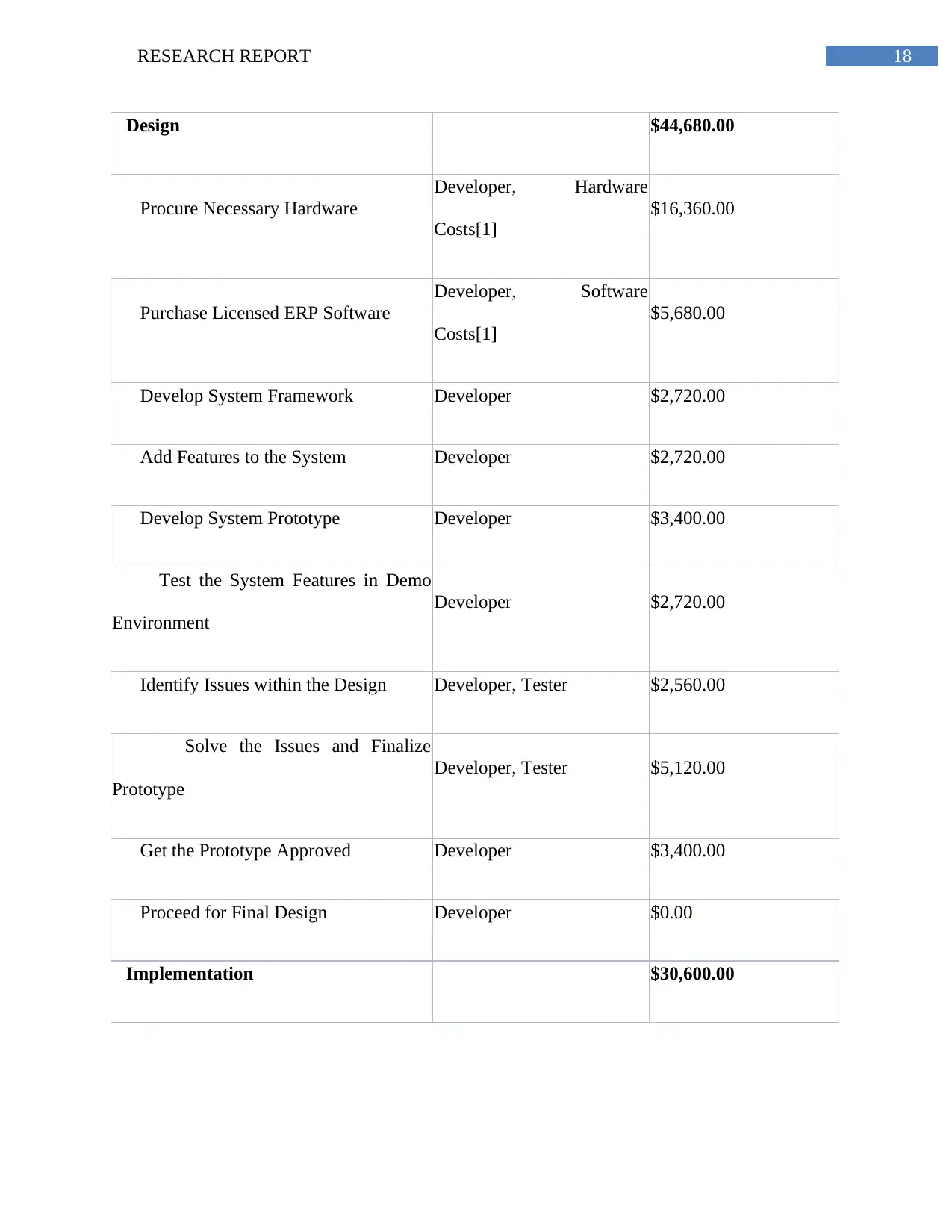
18RESEARCH REPORT
Design $44,680.00
Procure Necessary Hardware
Developer, Hardware
Costs[1]
$16,360.00
Purchase Licensed ERP Software
Developer, Software
Costs[1]
$5,680.00
Develop System Framework Developer $2,720.00
Add Features to the System Developer $2,720.00
Develop System Prototype Developer $3,400.00
Test the System Features in Demo
Environment
Developer $2,720.00
Identify Issues within the Design Developer, Tester $2,560.00
Solve the Issues and Finalize
Prototype
Developer, Tester $5,120.00
Get the Prototype Approved Developer $3,400.00
Proceed for Final Design Developer $0.00
Implementation $30,600.00
Design $44,680.00
Procure Necessary Hardware
Developer, Hardware
Costs[1]
$16,360.00
Purchase Licensed ERP Software
Developer, Software
Costs[1]
$5,680.00
Develop System Framework Developer $2,720.00
Add Features to the System Developer $2,720.00
Develop System Prototype Developer $3,400.00
Test the System Features in Demo
Environment
Developer $2,720.00
Identify Issues within the Design Developer, Tester $2,560.00
Solve the Issues and Finalize
Prototype
Developer, Tester $5,120.00
Get the Prototype Approved Developer $3,400.00
Proceed for Final Design Developer $0.00
Implementation $30,600.00
Paraphrase This Document
Need a fresh take? Get an instant paraphrase of this document with our AI Paraphraser

19RESEARCH REPORT
Develop Framework for the Final
System
Developer $6,800.00
Design Various Working Layers of the
System
Developer $6,800.00
Integrate the Features with the System Developer $6,800.00
Implement the System within Demo
Working Environment
Developer $3,400.00
Analyze the Integrated Features of the
System
Developer $4,080.00
Document the Analysis Results Developer $2,720.00
Testing $12,600.00
Start Testing the System Tester $600.00
Search for Bugs and Glitches Tester $6,000.00
Conduct Debugging Session Tester $1,200.00
White Box Testing Tester $1,200.00
Black Box Testing Tester $1,200.00
Performance Testing Tester $1,200.00
User Acceptance Testing Tester $1,200.00
Develop Framework for the Final
System
Developer $6,800.00
Design Various Working Layers of the
System
Developer $6,800.00
Integrate the Features with the System Developer $6,800.00
Implement the System within Demo
Working Environment
Developer $3,400.00
Analyze the Integrated Features of the
System
Developer $4,080.00
Document the Analysis Results Developer $2,720.00
Testing $12,600.00
Start Testing the System Tester $600.00
Search for Bugs and Glitches Tester $6,000.00
Conduct Debugging Session Tester $1,200.00
White Box Testing Tester $1,200.00
Black Box Testing Tester $1,200.00
Performance Testing Tester $1,200.00
User Acceptance Testing Tester $1,200.00
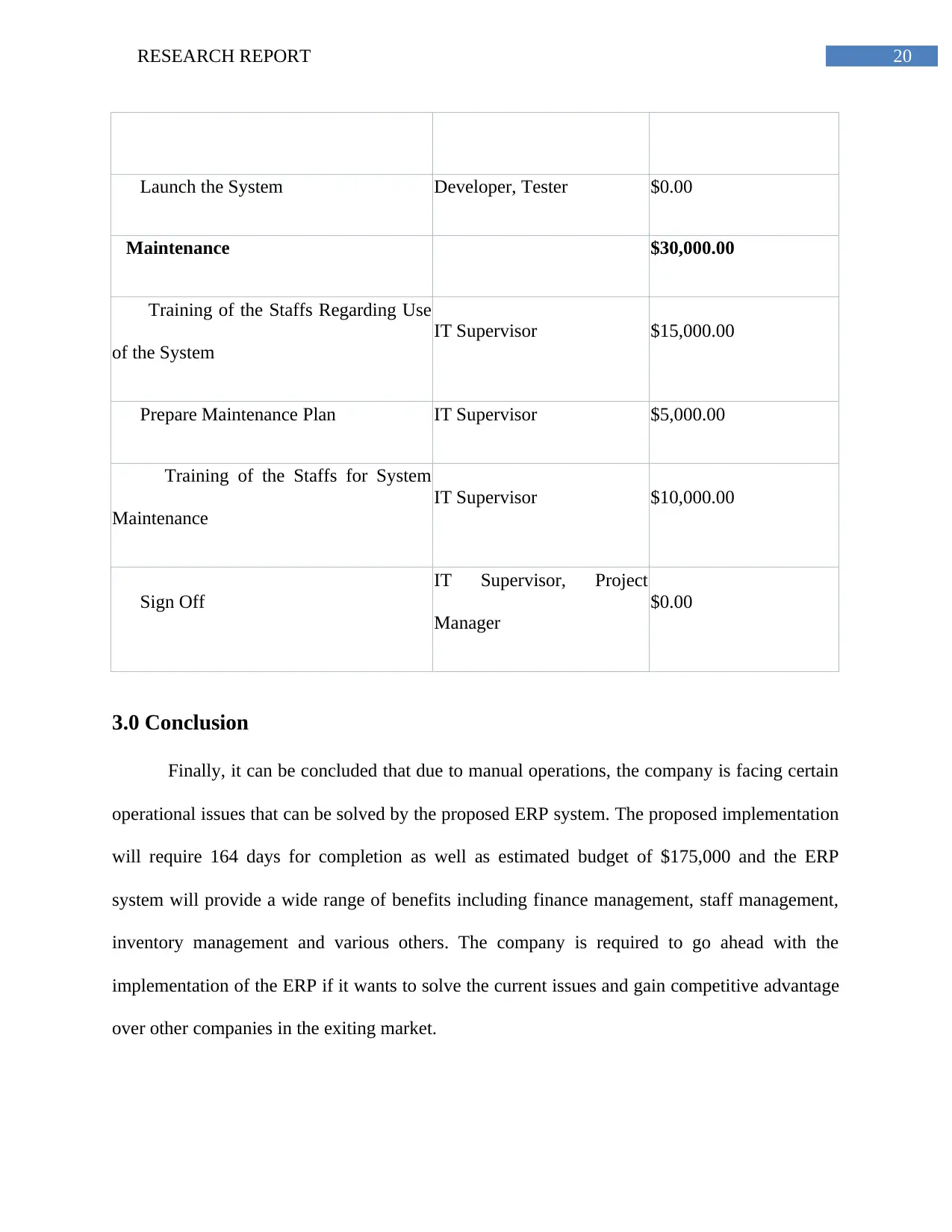
20RESEARCH REPORT
Launch the System Developer, Tester $0.00
Maintenance $30,000.00
Training of the Staffs Regarding Use
of the System
IT Supervisor $15,000.00
Prepare Maintenance Plan IT Supervisor $5,000.00
Training of the Staffs for System
Maintenance
IT Supervisor $10,000.00
Sign Off
IT Supervisor, Project
Manager
$0.00
3.0 Conclusion
Finally, it can be concluded that due to manual operations, the company is facing certain
operational issues that can be solved by the proposed ERP system. The proposed implementation
will require 164 days for completion as well as estimated budget of $175,000 and the ERP
system will provide a wide range of benefits including finance management, staff management,
inventory management and various others. The company is required to go ahead with the
implementation of the ERP if it wants to solve the current issues and gain competitive advantage
over other companies in the exiting market.
Launch the System Developer, Tester $0.00
Maintenance $30,000.00
Training of the Staffs Regarding Use
of the System
IT Supervisor $15,000.00
Prepare Maintenance Plan IT Supervisor $5,000.00
Training of the Staffs for System
Maintenance
IT Supervisor $10,000.00
Sign Off
IT Supervisor, Project
Manager
$0.00
3.0 Conclusion
Finally, it can be concluded that due to manual operations, the company is facing certain
operational issues that can be solved by the proposed ERP system. The proposed implementation
will require 164 days for completion as well as estimated budget of $175,000 and the ERP
system will provide a wide range of benefits including finance management, staff management,
inventory management and various others. The company is required to go ahead with the
implementation of the ERP if it wants to solve the current issues and gain competitive advantage
over other companies in the exiting market.
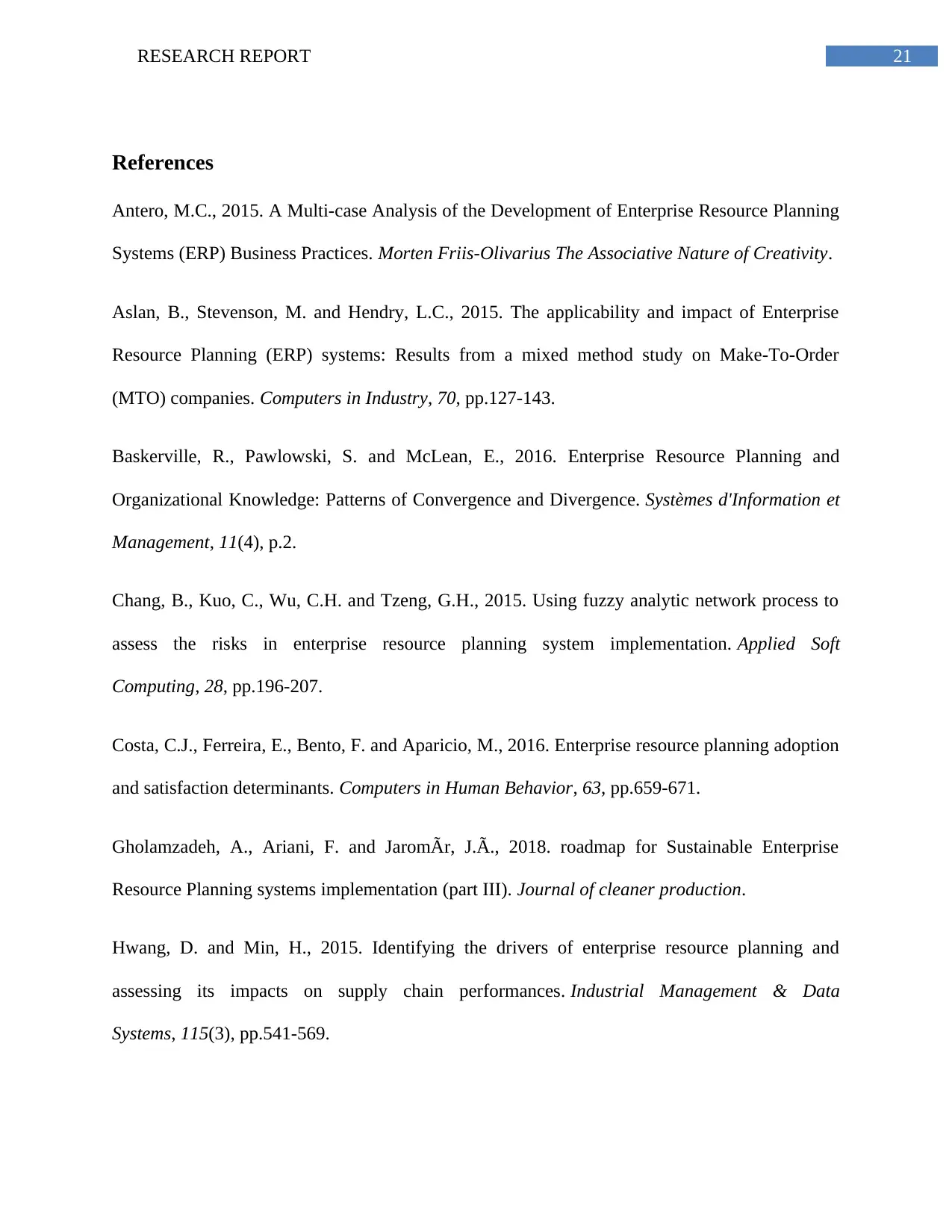
21RESEARCH REPORT
References
Antero, M.C., 2015. A Multi-case Analysis of the Development of Enterprise Resource Planning
Systems (ERP) Business Practices. Morten Friis-Olivarius The Associative Nature of Creativity.
Aslan, B., Stevenson, M. and Hendry, L.C., 2015. The applicability and impact of Enterprise
Resource Planning (ERP) systems: Results from a mixed method study on Make-To-Order
(MTO) companies. Computers in Industry, 70, pp.127-143.
Baskerville, R., Pawlowski, S. and McLean, E., 2016. Enterprise Resource Planning and
Organizational Knowledge: Patterns of Convergence and Divergence. Systèmes d'Information et
Management, 11(4), p.2.
Chang, B., Kuo, C., Wu, C.H. and Tzeng, G.H., 2015. Using fuzzy analytic network process to
assess the risks in enterprise resource planning system implementation. Applied Soft
Computing, 28, pp.196-207.
Costa, C.J., Ferreira, E., Bento, F. and Aparicio, M., 2016. Enterprise resource planning adoption
and satisfaction determinants. Computers in Human Behavior, 63, pp.659-671.
Gholamzadeh, A., Ariani, F. and JaromÃr, J.Ã., 2018. roadmap for Sustainable Enterprise
Resource Planning systems implementation (part III). Journal of cleaner production.
Hwang, D. and Min, H., 2015. Identifying the drivers of enterprise resource planning and
assessing its impacts on supply chain performances. Industrial Management & Data
Systems, 115(3), pp.541-569.
References
Antero, M.C., 2015. A Multi-case Analysis of the Development of Enterprise Resource Planning
Systems (ERP) Business Practices. Morten Friis-Olivarius The Associative Nature of Creativity.
Aslan, B., Stevenson, M. and Hendry, L.C., 2015. The applicability and impact of Enterprise
Resource Planning (ERP) systems: Results from a mixed method study on Make-To-Order
(MTO) companies. Computers in Industry, 70, pp.127-143.
Baskerville, R., Pawlowski, S. and McLean, E., 2016. Enterprise Resource Planning and
Organizational Knowledge: Patterns of Convergence and Divergence. Systèmes d'Information et
Management, 11(4), p.2.
Chang, B., Kuo, C., Wu, C.H. and Tzeng, G.H., 2015. Using fuzzy analytic network process to
assess the risks in enterprise resource planning system implementation. Applied Soft
Computing, 28, pp.196-207.
Costa, C.J., Ferreira, E., Bento, F. and Aparicio, M., 2016. Enterprise resource planning adoption
and satisfaction determinants. Computers in Human Behavior, 63, pp.659-671.
Gholamzadeh, A., Ariani, F. and JaromÃr, J.Ã., 2018. roadmap for Sustainable Enterprise
Resource Planning systems implementation (part III). Journal of cleaner production.
Hwang, D. and Min, H., 2015. Identifying the drivers of enterprise resource planning and
assessing its impacts on supply chain performances. Industrial Management & Data
Systems, 115(3), pp.541-569.
Secure Best Marks with AI Grader
Need help grading? Try our AI Grader for instant feedback on your assignments.
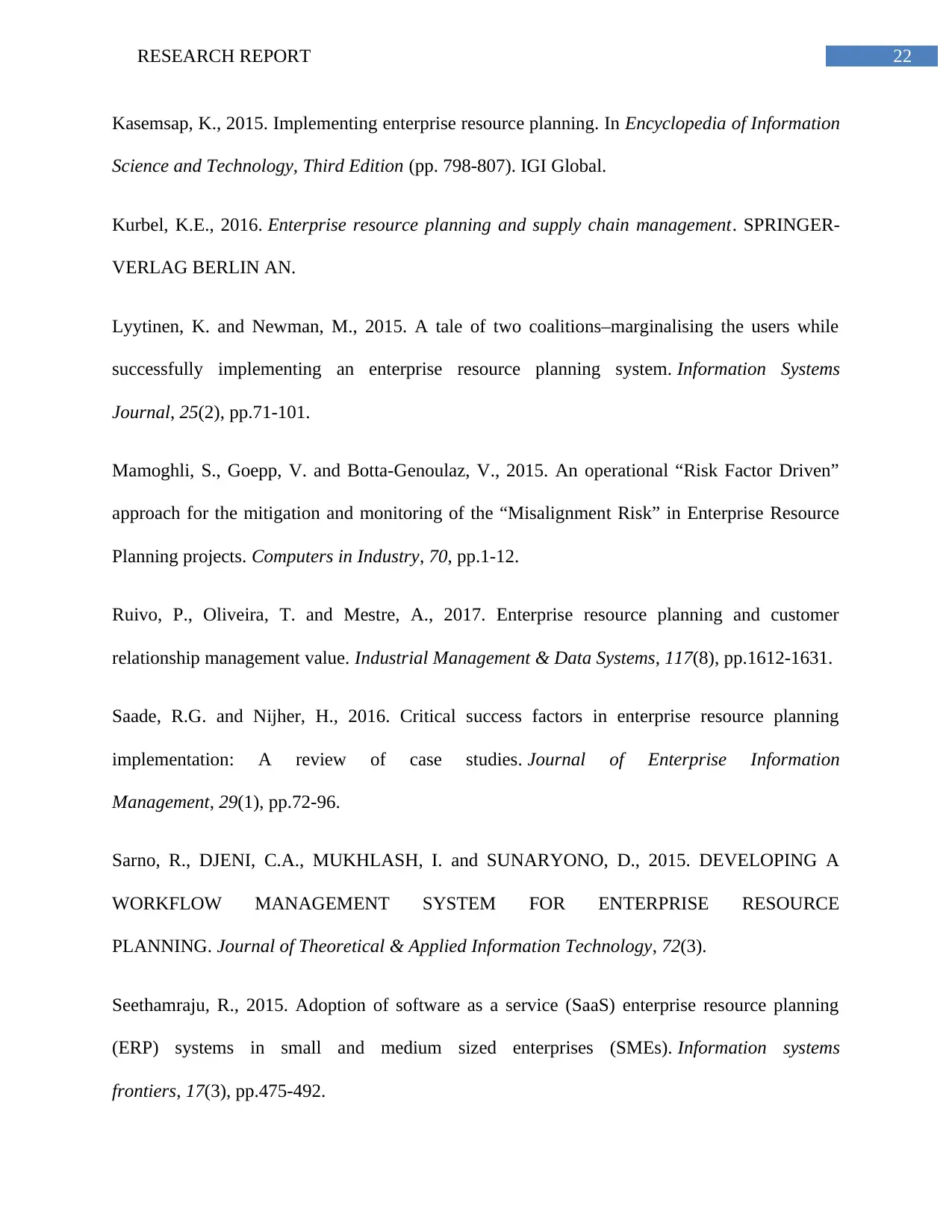
22RESEARCH REPORT
Kasemsap, K., 2015. Implementing enterprise resource planning. In Encyclopedia of Information
Science and Technology, Third Edition (pp. 798-807). IGI Global.
Kurbel, K.E., 2016. Enterprise resource planning and supply chain management. SPRINGER-
VERLAG BERLIN AN.
Lyytinen, K. and Newman, M., 2015. A tale of two coalitions–marginalising the users while
successfully implementing an enterprise resource planning system. Information Systems
Journal, 25(2), pp.71-101.
Mamoghli, S., Goepp, V. and Botta-Genoulaz, V., 2015. An operational “Risk Factor Driven”
approach for the mitigation and monitoring of the “Misalignment Risk” in Enterprise Resource
Planning projects. Computers in Industry, 70, pp.1-12.
Ruivo, P., Oliveira, T. and Mestre, A., 2017. Enterprise resource planning and customer
relationship management value. Industrial Management & Data Systems, 117(8), pp.1612-1631.
Saade, R.G. and Nijher, H., 2016. Critical success factors in enterprise resource planning
implementation: A review of case studies. Journal of Enterprise Information
Management, 29(1), pp.72-96.
Sarno, R., DJENI, C.A., MUKHLASH, I. and SUNARYONO, D., 2015. DEVELOPING A
WORKFLOW MANAGEMENT SYSTEM FOR ENTERPRISE RESOURCE
PLANNING. Journal of Theoretical & Applied Information Technology, 72(3).
Seethamraju, R., 2015. Adoption of software as a service (SaaS) enterprise resource planning
(ERP) systems in small and medium sized enterprises (SMEs). Information systems
frontiers, 17(3), pp.475-492.
Kasemsap, K., 2015. Implementing enterprise resource planning. In Encyclopedia of Information
Science and Technology, Third Edition (pp. 798-807). IGI Global.
Kurbel, K.E., 2016. Enterprise resource planning and supply chain management. SPRINGER-
VERLAG BERLIN AN.
Lyytinen, K. and Newman, M., 2015. A tale of two coalitions–marginalising the users while
successfully implementing an enterprise resource planning system. Information Systems
Journal, 25(2), pp.71-101.
Mamoghli, S., Goepp, V. and Botta-Genoulaz, V., 2015. An operational “Risk Factor Driven”
approach for the mitigation and monitoring of the “Misalignment Risk” in Enterprise Resource
Planning projects. Computers in Industry, 70, pp.1-12.
Ruivo, P., Oliveira, T. and Mestre, A., 2017. Enterprise resource planning and customer
relationship management value. Industrial Management & Data Systems, 117(8), pp.1612-1631.
Saade, R.G. and Nijher, H., 2016. Critical success factors in enterprise resource planning
implementation: A review of case studies. Journal of Enterprise Information
Management, 29(1), pp.72-96.
Sarno, R., DJENI, C.A., MUKHLASH, I. and SUNARYONO, D., 2015. DEVELOPING A
WORKFLOW MANAGEMENT SYSTEM FOR ENTERPRISE RESOURCE
PLANNING. Journal of Theoretical & Applied Information Technology, 72(3).
Seethamraju, R., 2015. Adoption of software as a service (SaaS) enterprise resource planning
(ERP) systems in small and medium sized enterprises (SMEs). Information systems
frontiers, 17(3), pp.475-492.
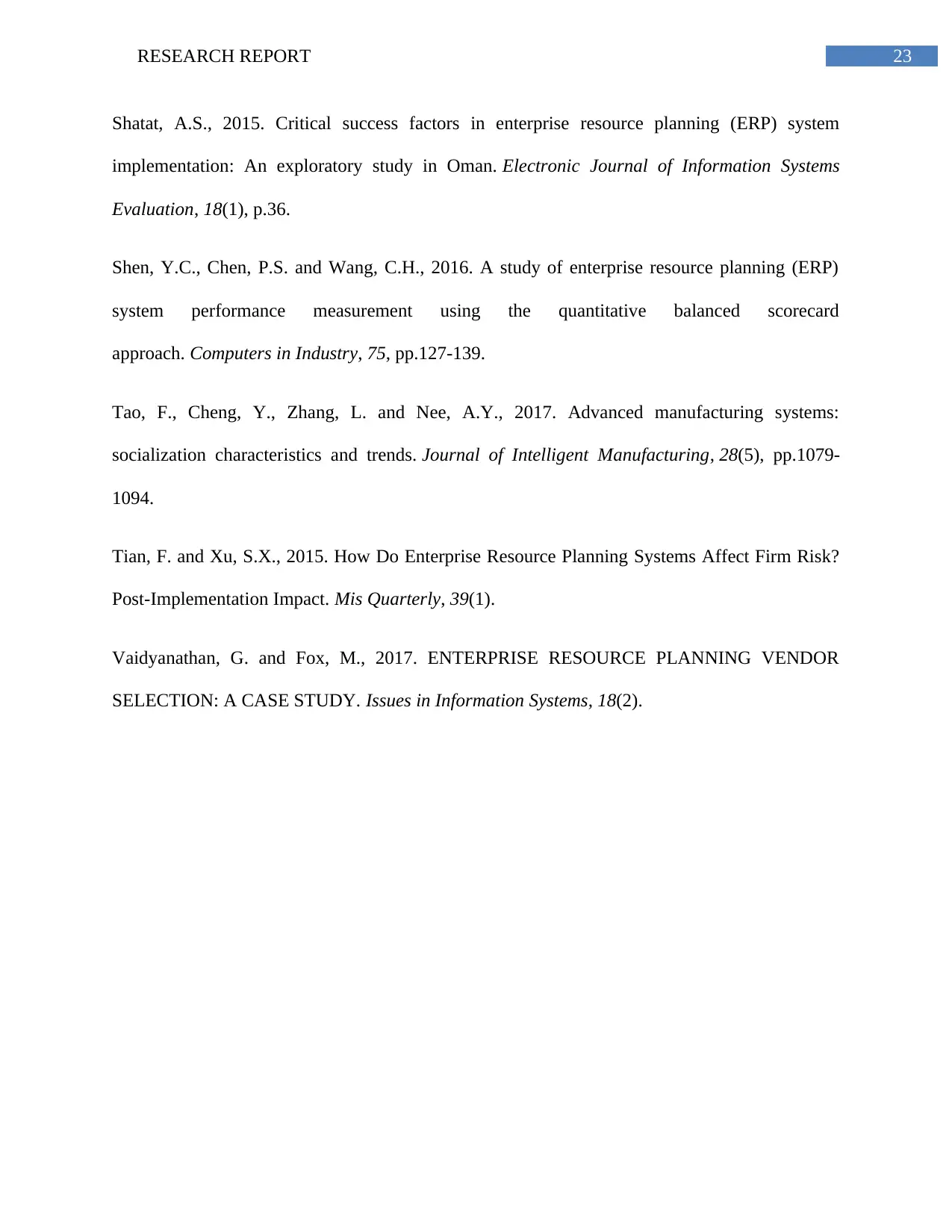
23RESEARCH REPORT
Shatat, A.S., 2015. Critical success factors in enterprise resource planning (ERP) system
implementation: An exploratory study in Oman. Electronic Journal of Information Systems
Evaluation, 18(1), p.36.
Shen, Y.C., Chen, P.S. and Wang, C.H., 2016. A study of enterprise resource planning (ERP)
system performance measurement using the quantitative balanced scorecard
approach. Computers in Industry, 75, pp.127-139.
Tao, F., Cheng, Y., Zhang, L. and Nee, A.Y., 2017. Advanced manufacturing systems:
socialization characteristics and trends. Journal of Intelligent Manufacturing, 28(5), pp.1079-
1094.
Tian, F. and Xu, S.X., 2015. How Do Enterprise Resource Planning Systems Affect Firm Risk?
Post-Implementation Impact. Mis Quarterly, 39(1).
Vaidyanathan, G. and Fox, M., 2017. ENTERPRISE RESOURCE PLANNING VENDOR
SELECTION: A CASE STUDY. Issues in Information Systems, 18(2).
Shatat, A.S., 2015. Critical success factors in enterprise resource planning (ERP) system
implementation: An exploratory study in Oman. Electronic Journal of Information Systems
Evaluation, 18(1), p.36.
Shen, Y.C., Chen, P.S. and Wang, C.H., 2016. A study of enterprise resource planning (ERP)
system performance measurement using the quantitative balanced scorecard
approach. Computers in Industry, 75, pp.127-139.
Tao, F., Cheng, Y., Zhang, L. and Nee, A.Y., 2017. Advanced manufacturing systems:
socialization characteristics and trends. Journal of Intelligent Manufacturing, 28(5), pp.1079-
1094.
Tian, F. and Xu, S.X., 2015. How Do Enterprise Resource Planning Systems Affect Firm Risk?
Post-Implementation Impact. Mis Quarterly, 39(1).
Vaidyanathan, G. and Fox, M., 2017. ENTERPRISE RESOURCE PLANNING VENDOR
SELECTION: A CASE STUDY. Issues in Information Systems, 18(2).
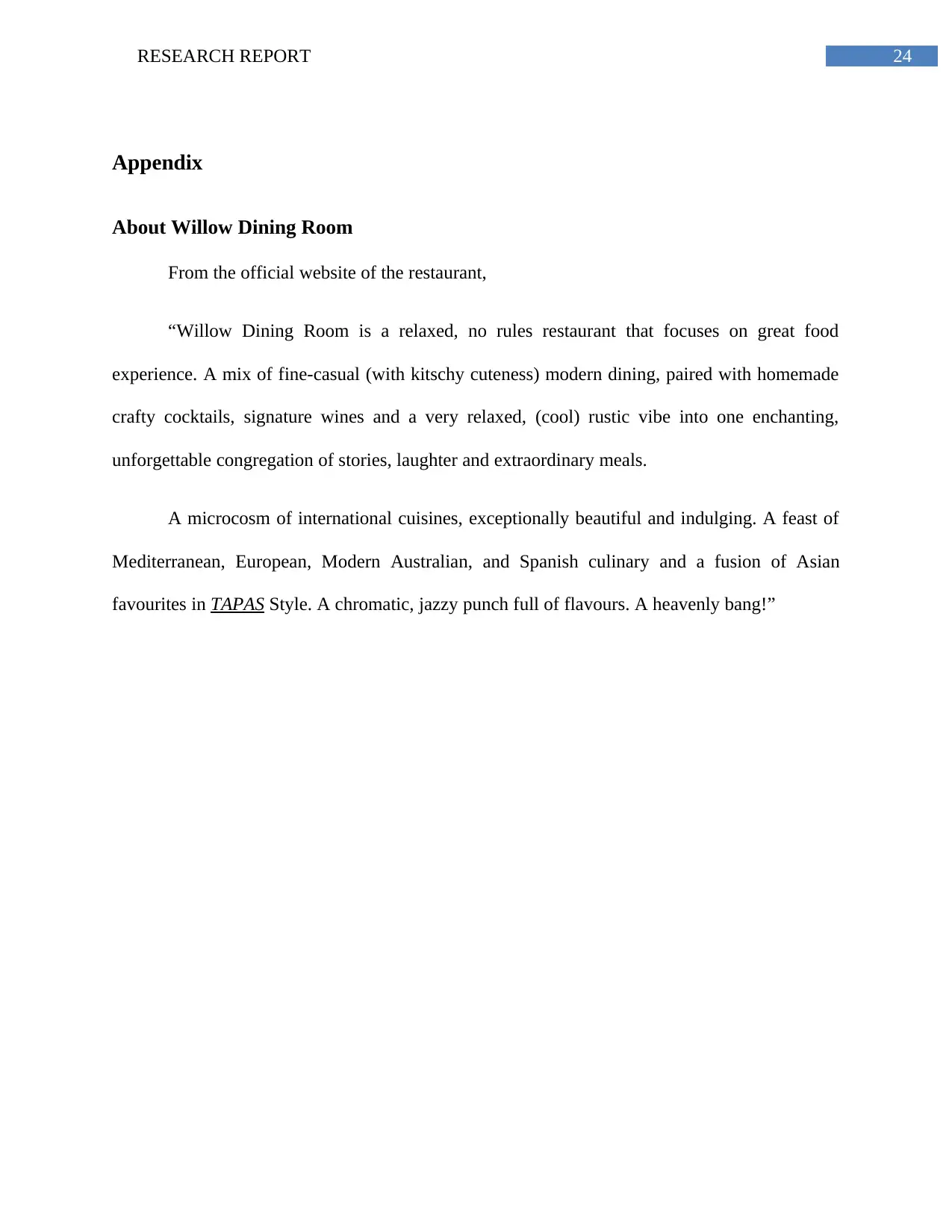
24RESEARCH REPORT
Appendix
About Willow Dining Room
From the official website of the restaurant,
“Willow Dining Room is a relaxed, no rules restaurant that focuses on great food
experience. A mix of fine-casual (with kitschy cuteness) modern dining, paired with homemade
crafty cocktails, signature wines and a very relaxed, (cool) rustic vibe into one enchanting,
unforgettable congregation of stories, laughter and extraordinary meals.
A microcosm of international cuisines, exceptionally beautiful and indulging. A feast of
Mediterranean, European, Modern Australian, and Spanish culinary and a fusion of Asian
favourites in TAPAS Style. A chromatic, jazzy punch full of flavours. A heavenly bang!”
Appendix
About Willow Dining Room
From the official website of the restaurant,
“Willow Dining Room is a relaxed, no rules restaurant that focuses on great food
experience. A mix of fine-casual (with kitschy cuteness) modern dining, paired with homemade
crafty cocktails, signature wines and a very relaxed, (cool) rustic vibe into one enchanting,
unforgettable congregation of stories, laughter and extraordinary meals.
A microcosm of international cuisines, exceptionally beautiful and indulging. A feast of
Mediterranean, European, Modern Australian, and Spanish culinary and a fusion of Asian
favourites in TAPAS Style. A chromatic, jazzy punch full of flavours. A heavenly bang!”
1 out of 25
Your All-in-One AI-Powered Toolkit for Academic Success.
+13062052269
info@desklib.com
Available 24*7 on WhatsApp / Email
![[object Object]](/_next/static/media/star-bottom.7253800d.svg)
Unlock your academic potential
© 2024 | Zucol Services PVT LTD | All rights reserved.



